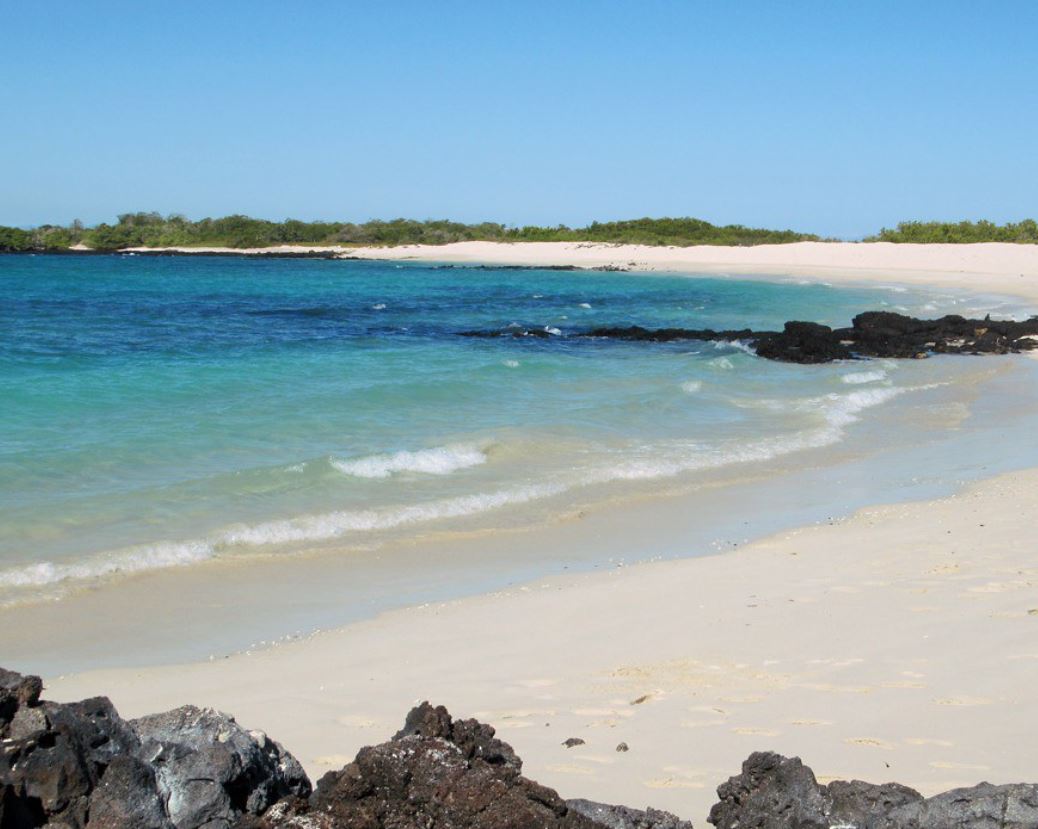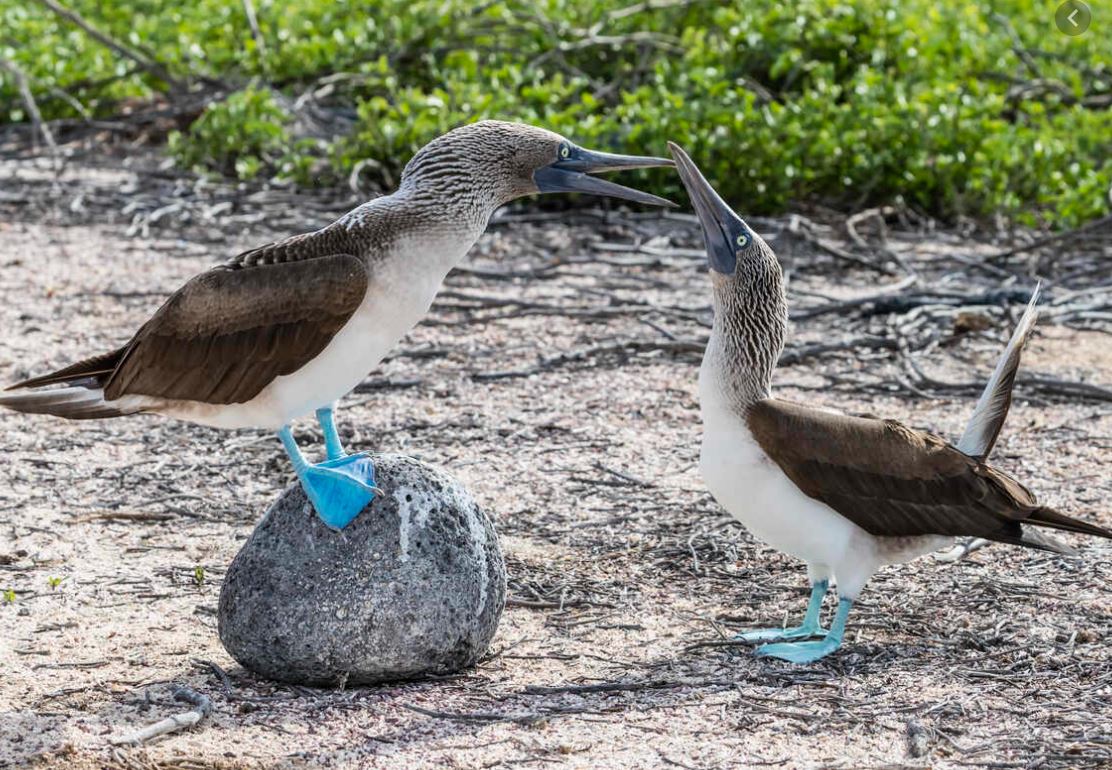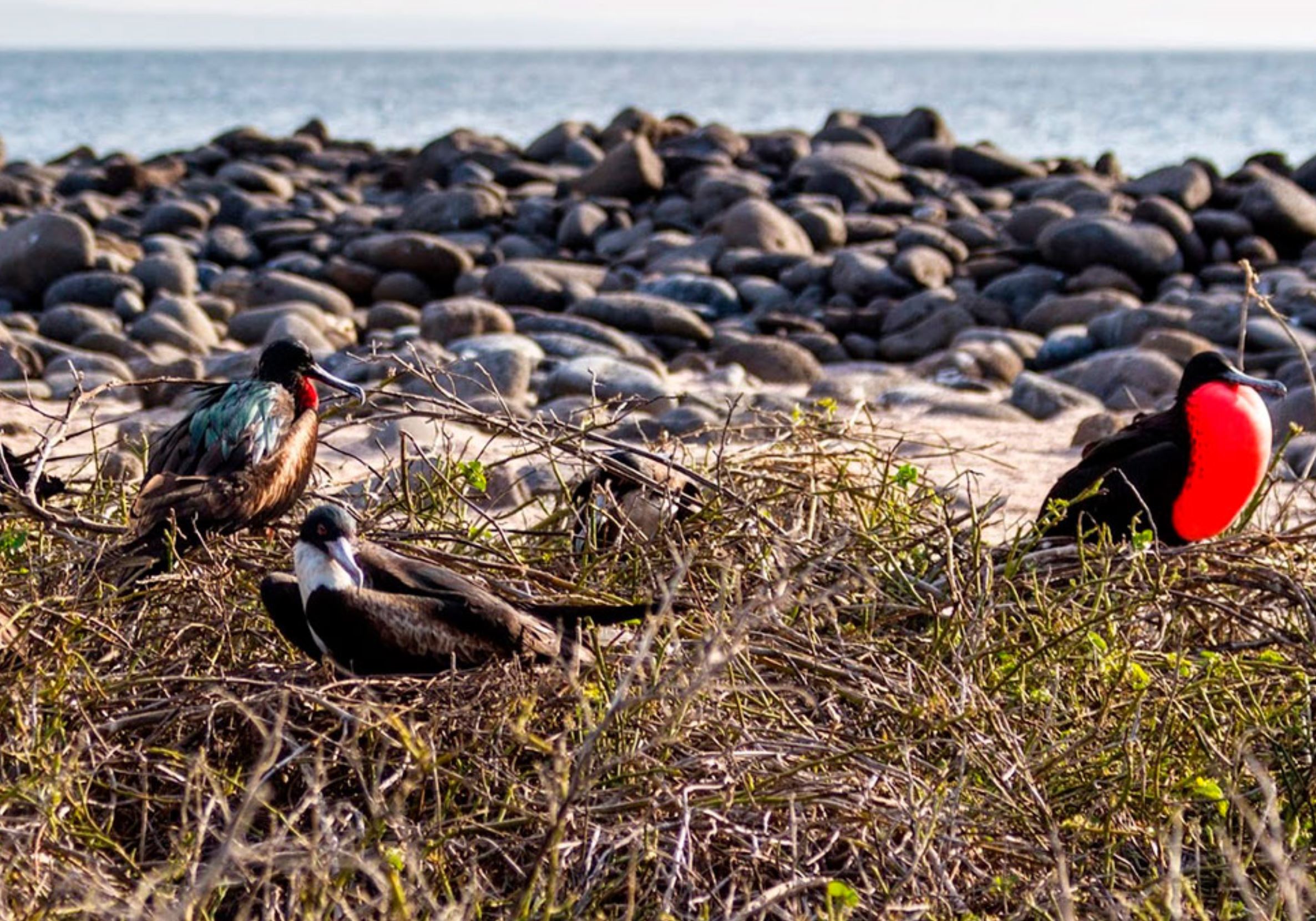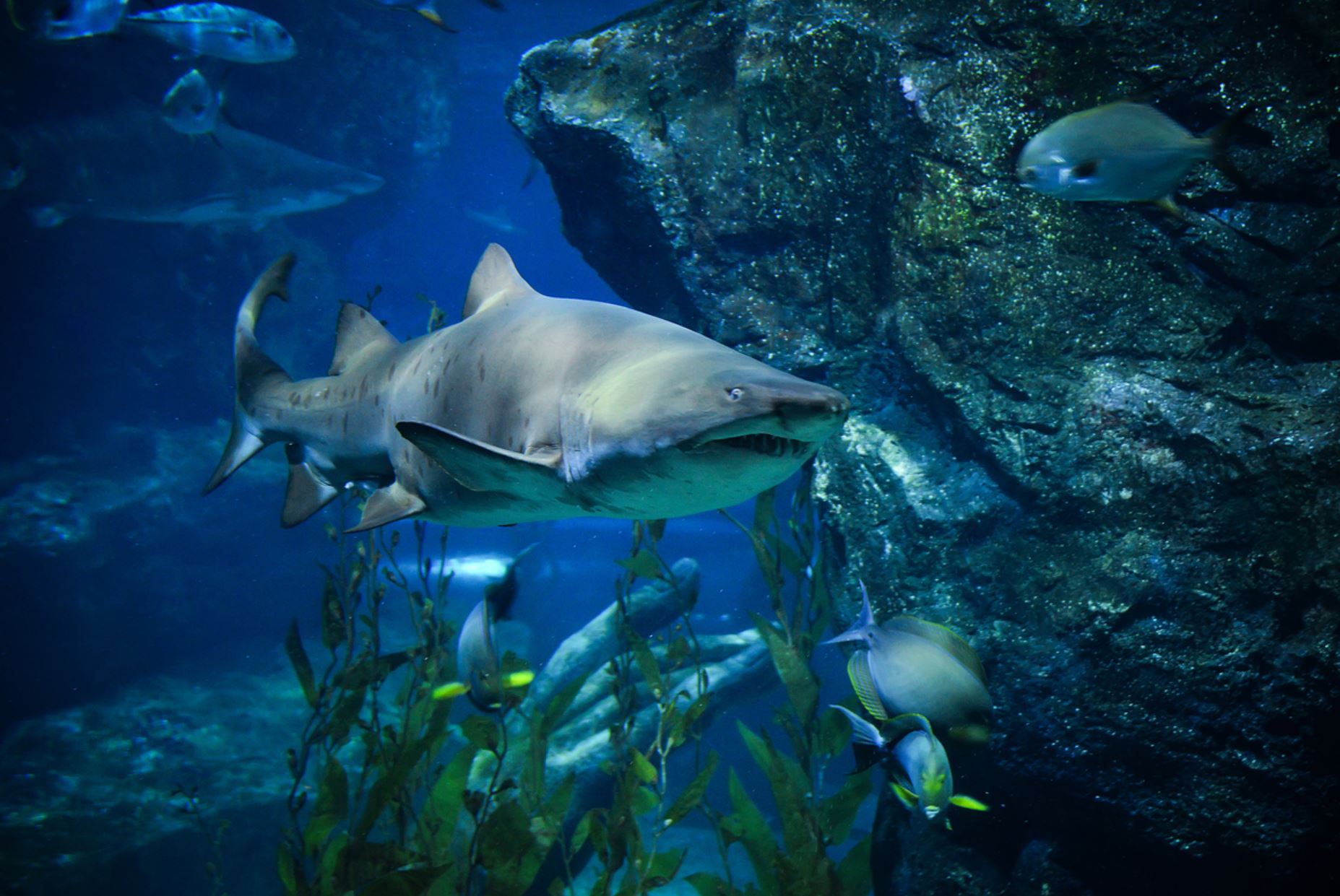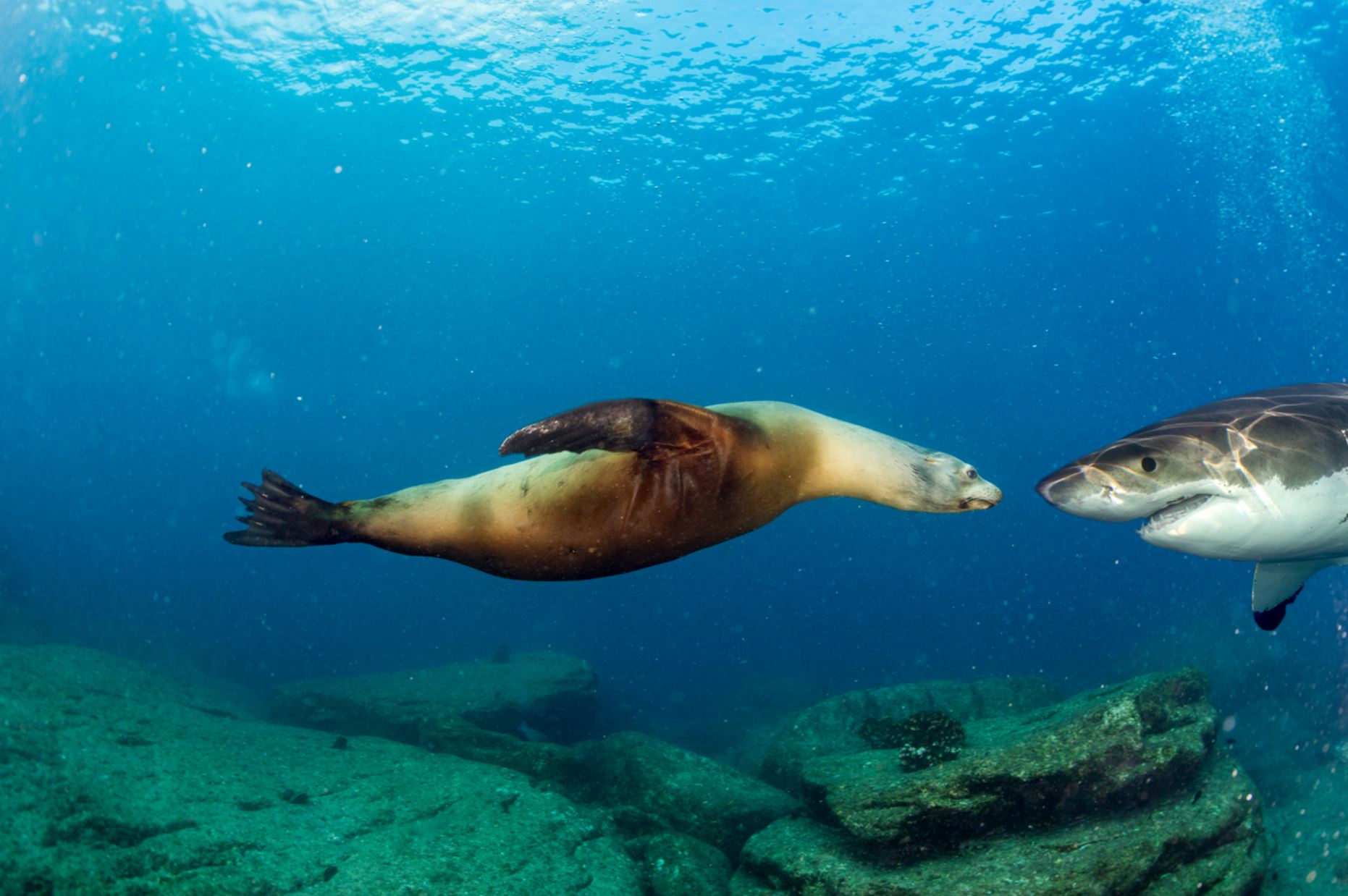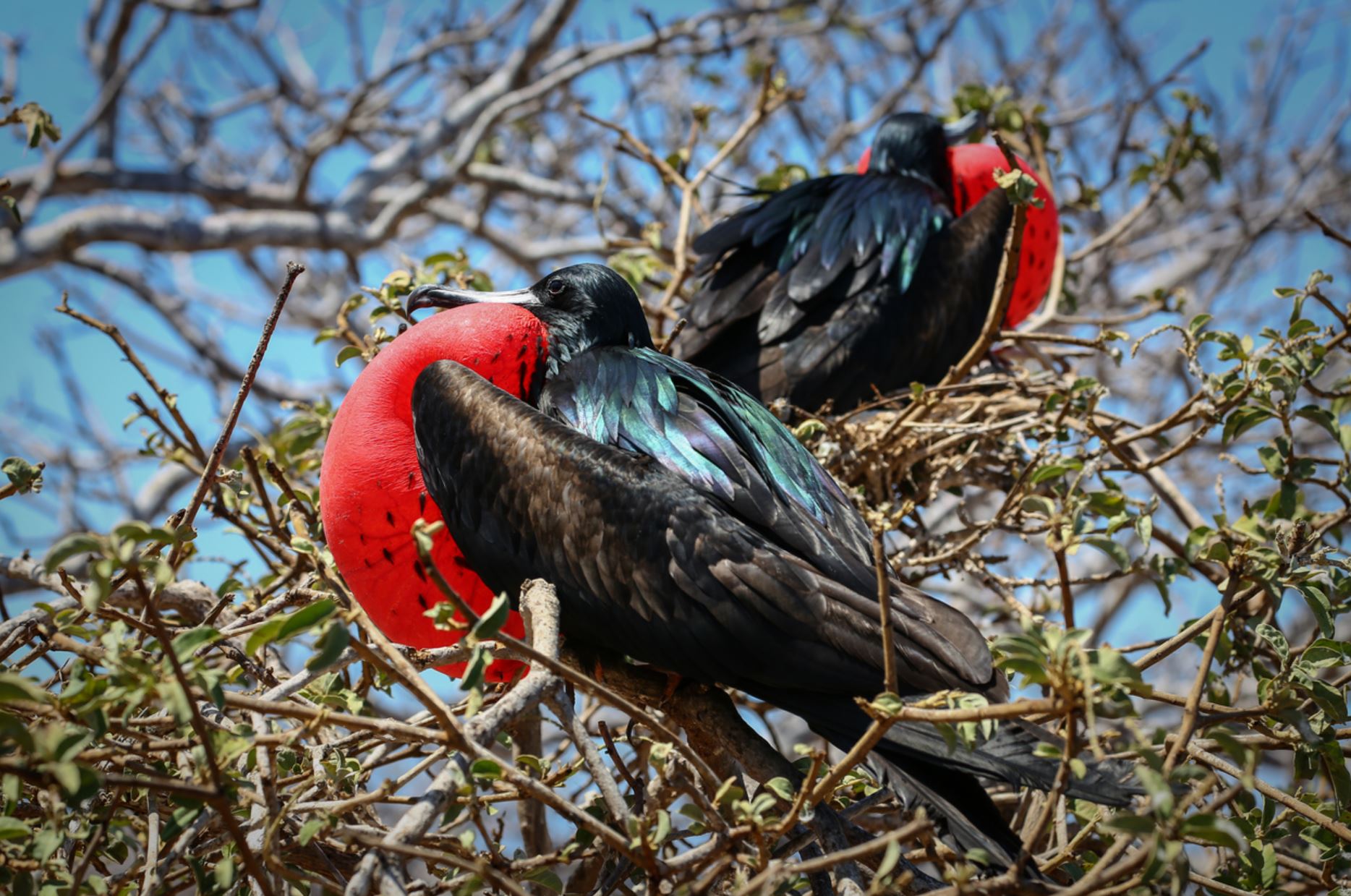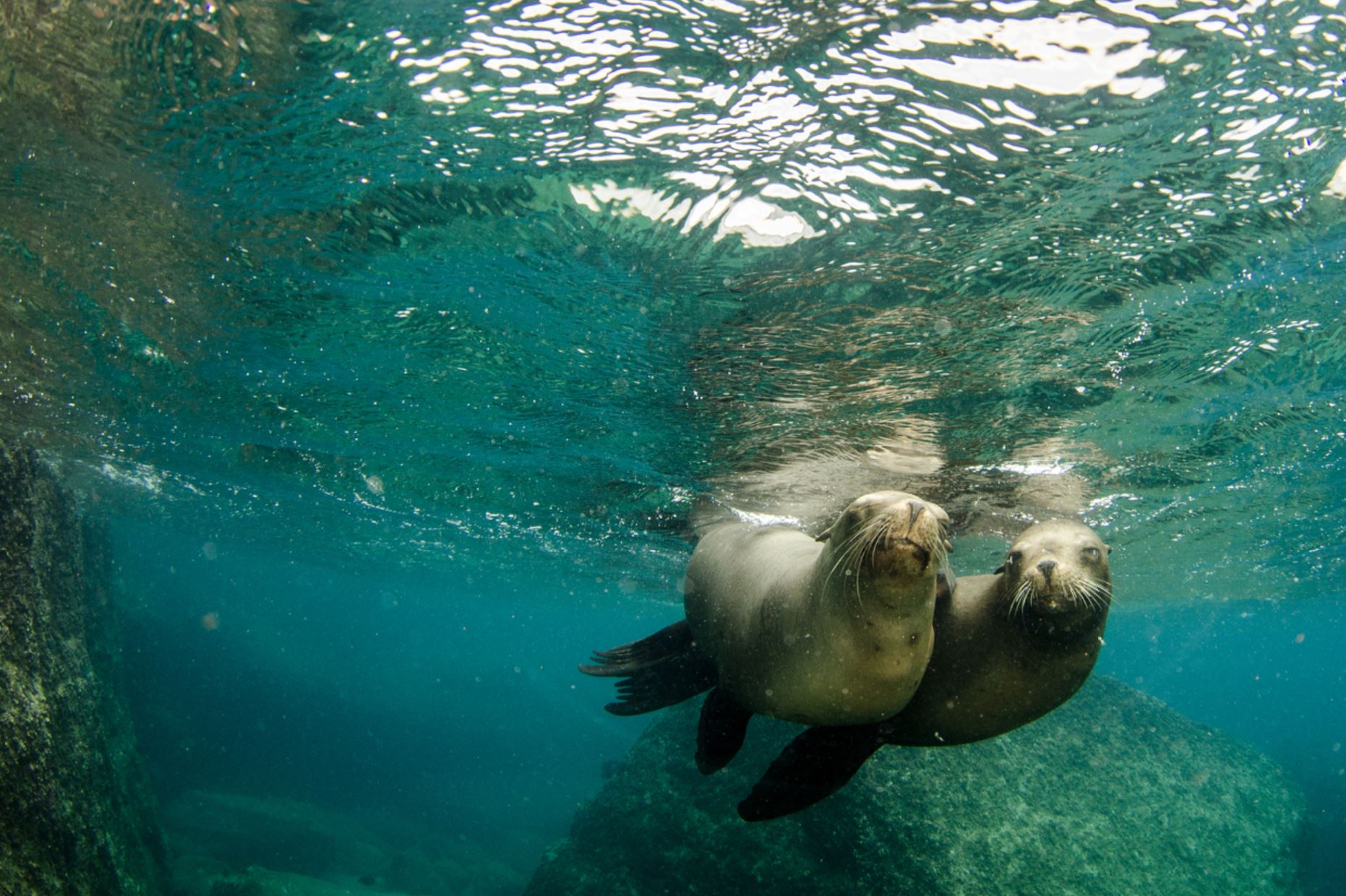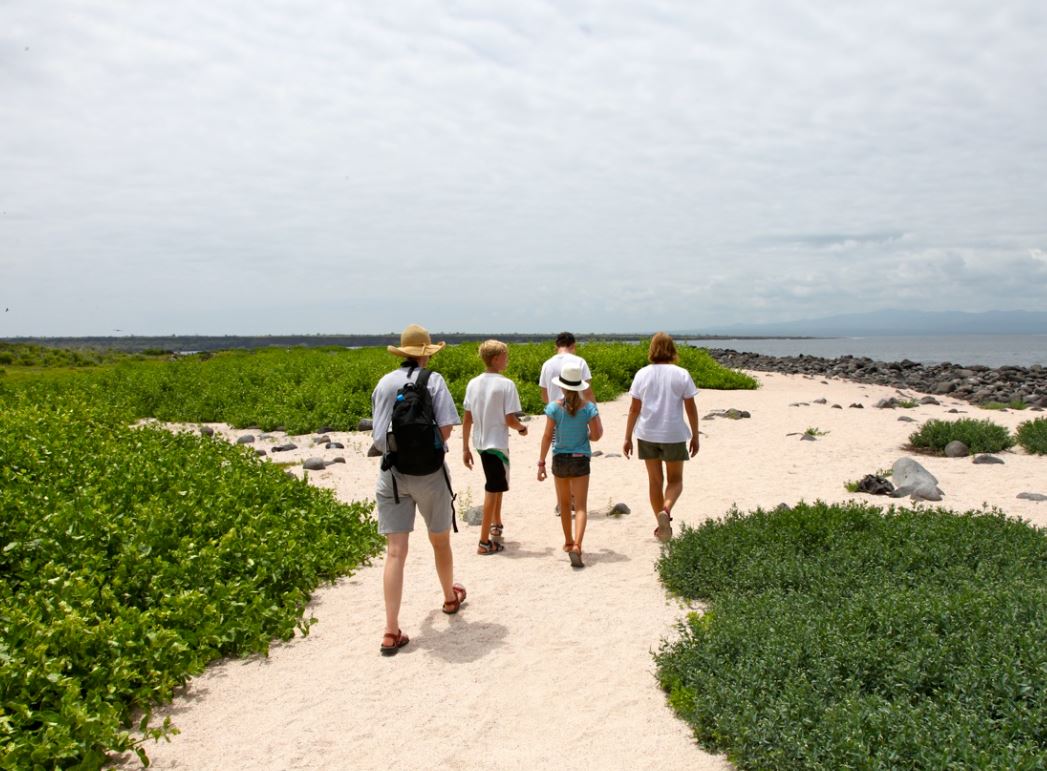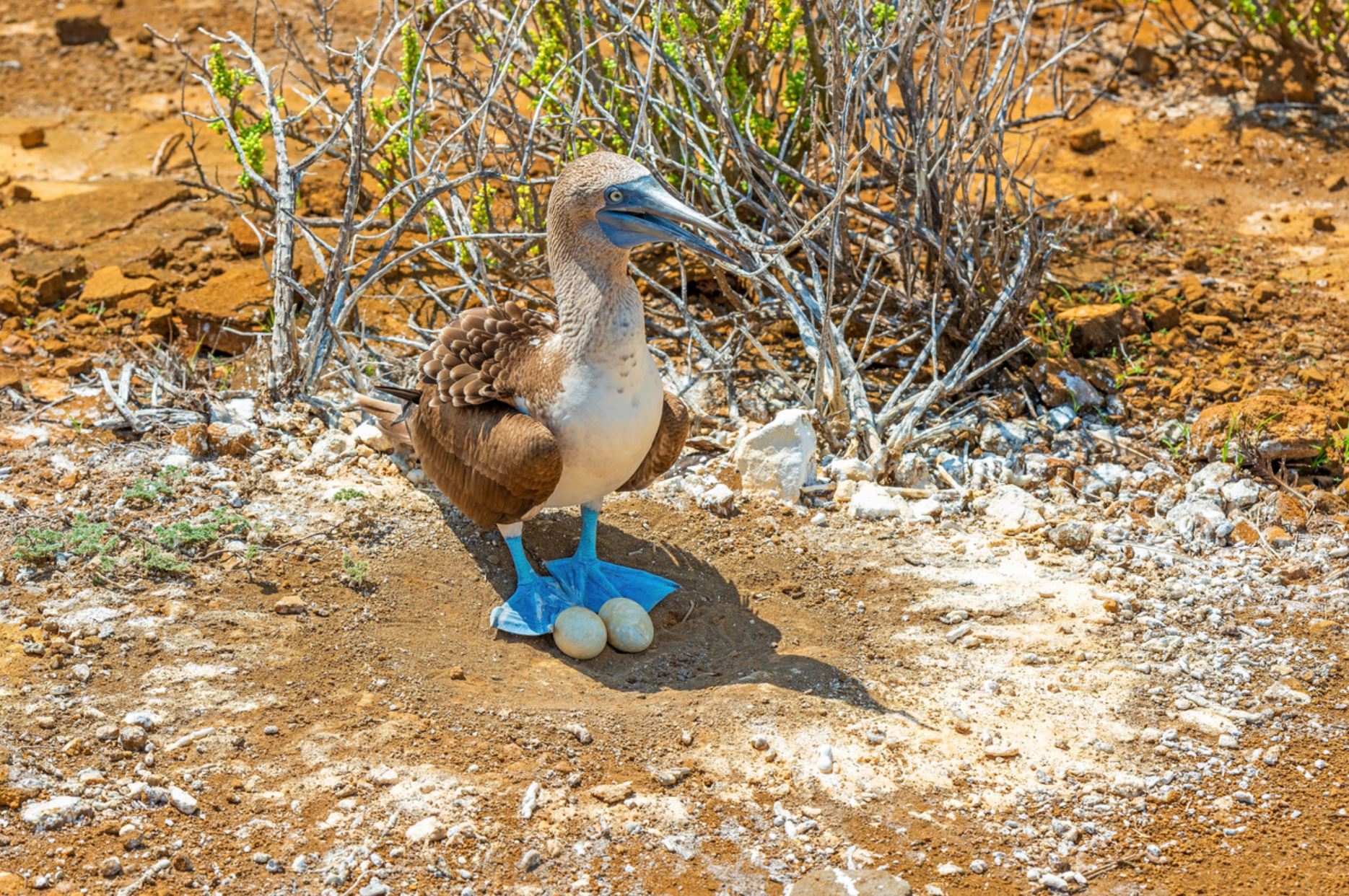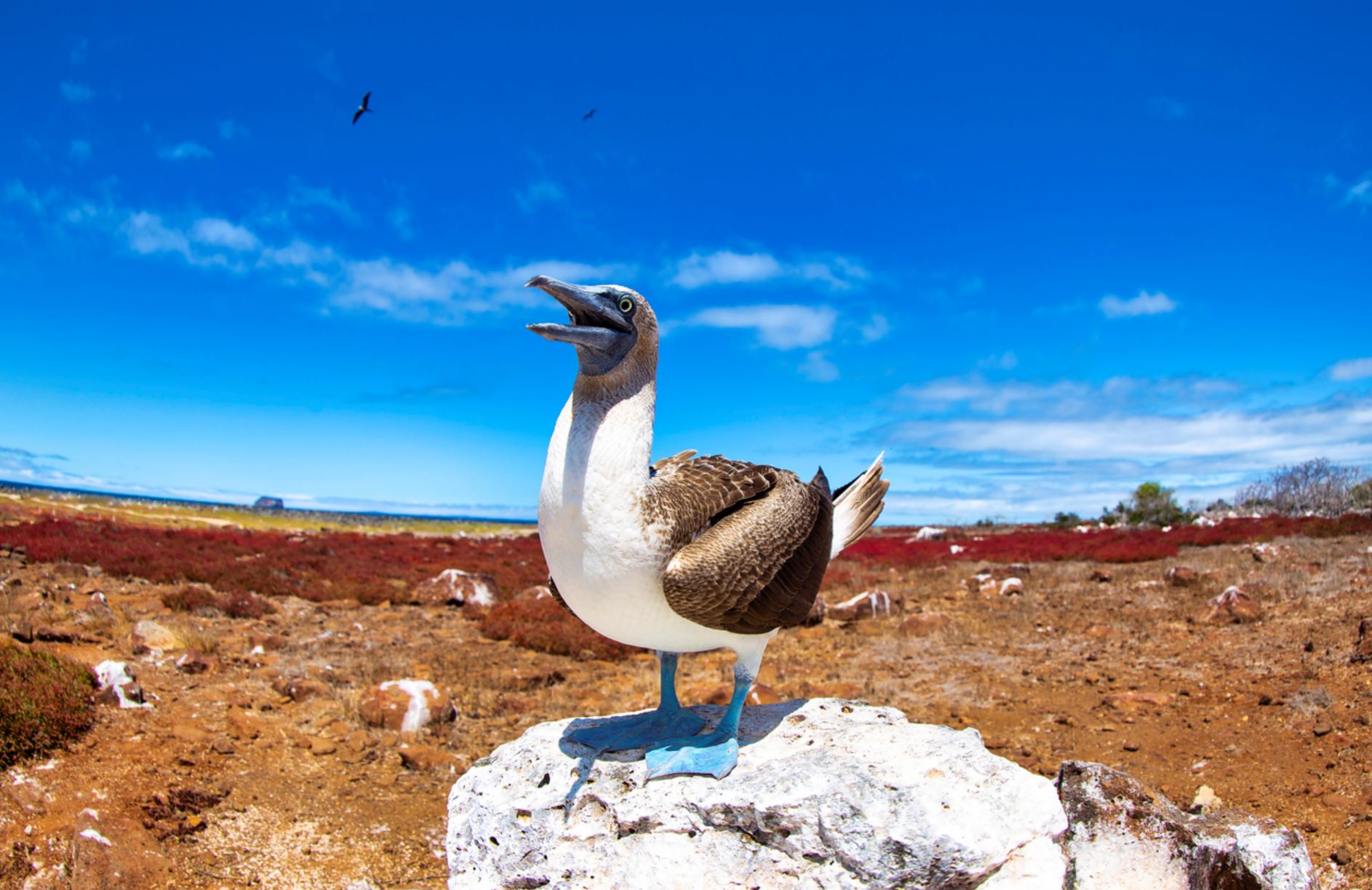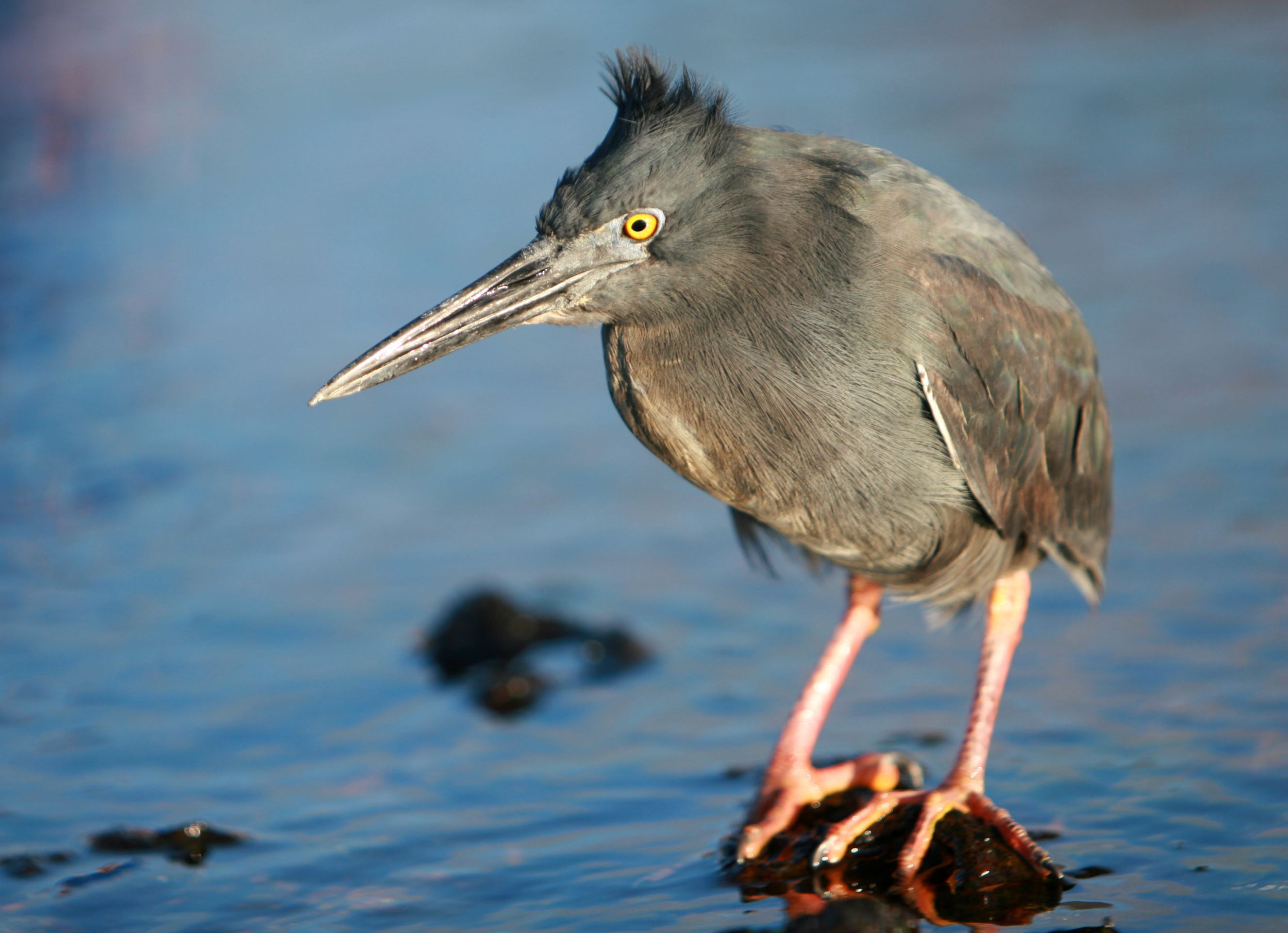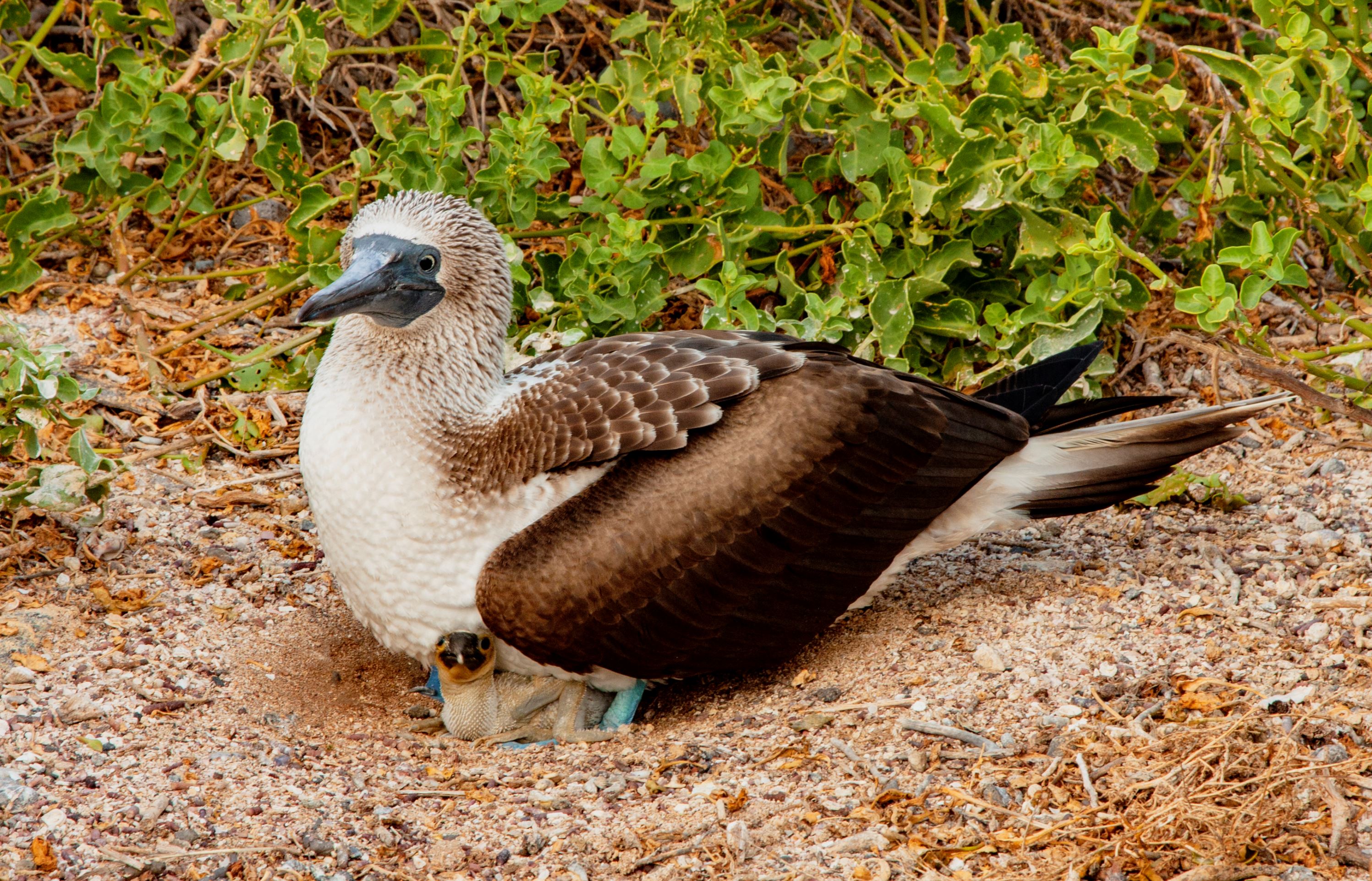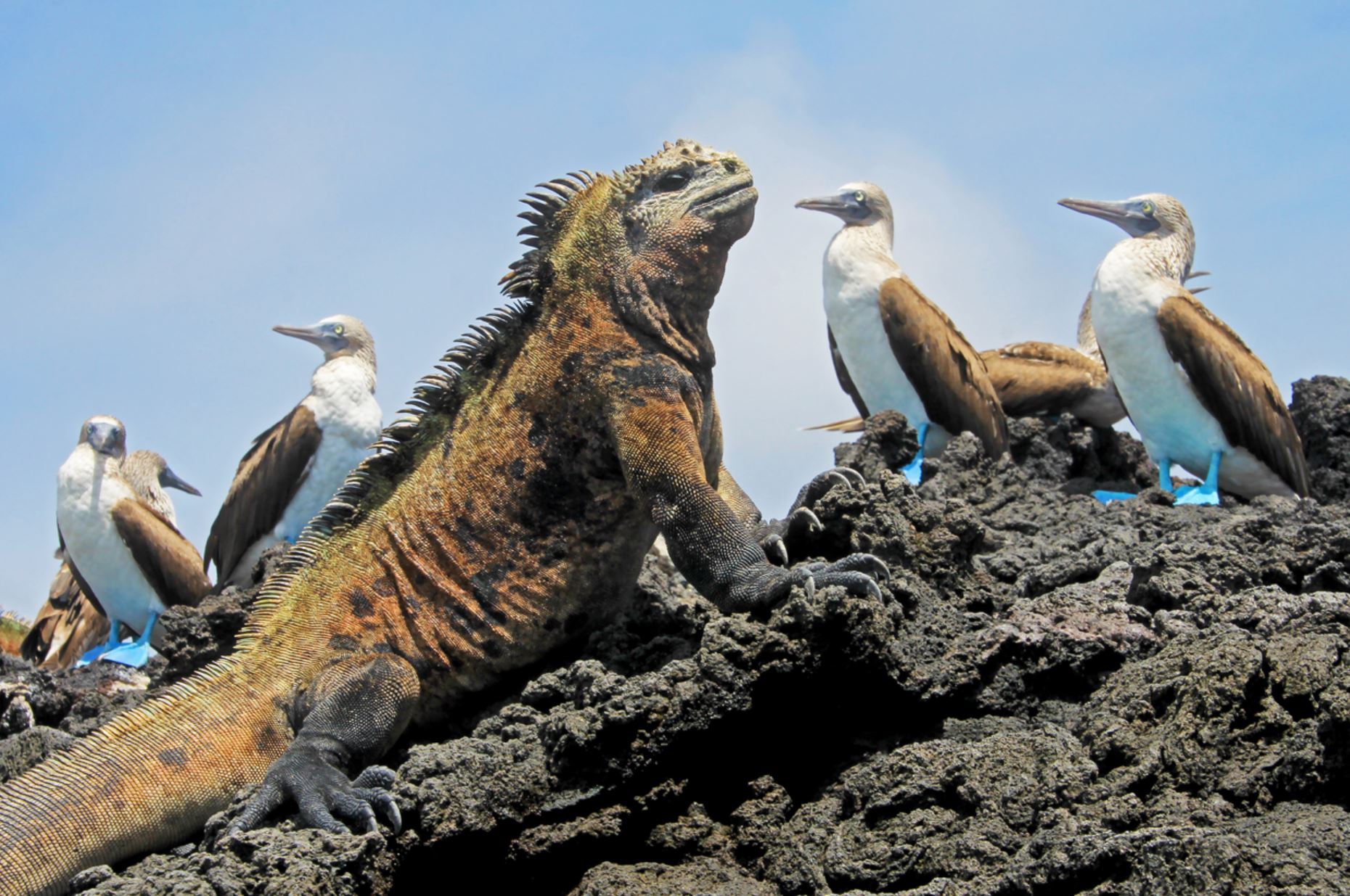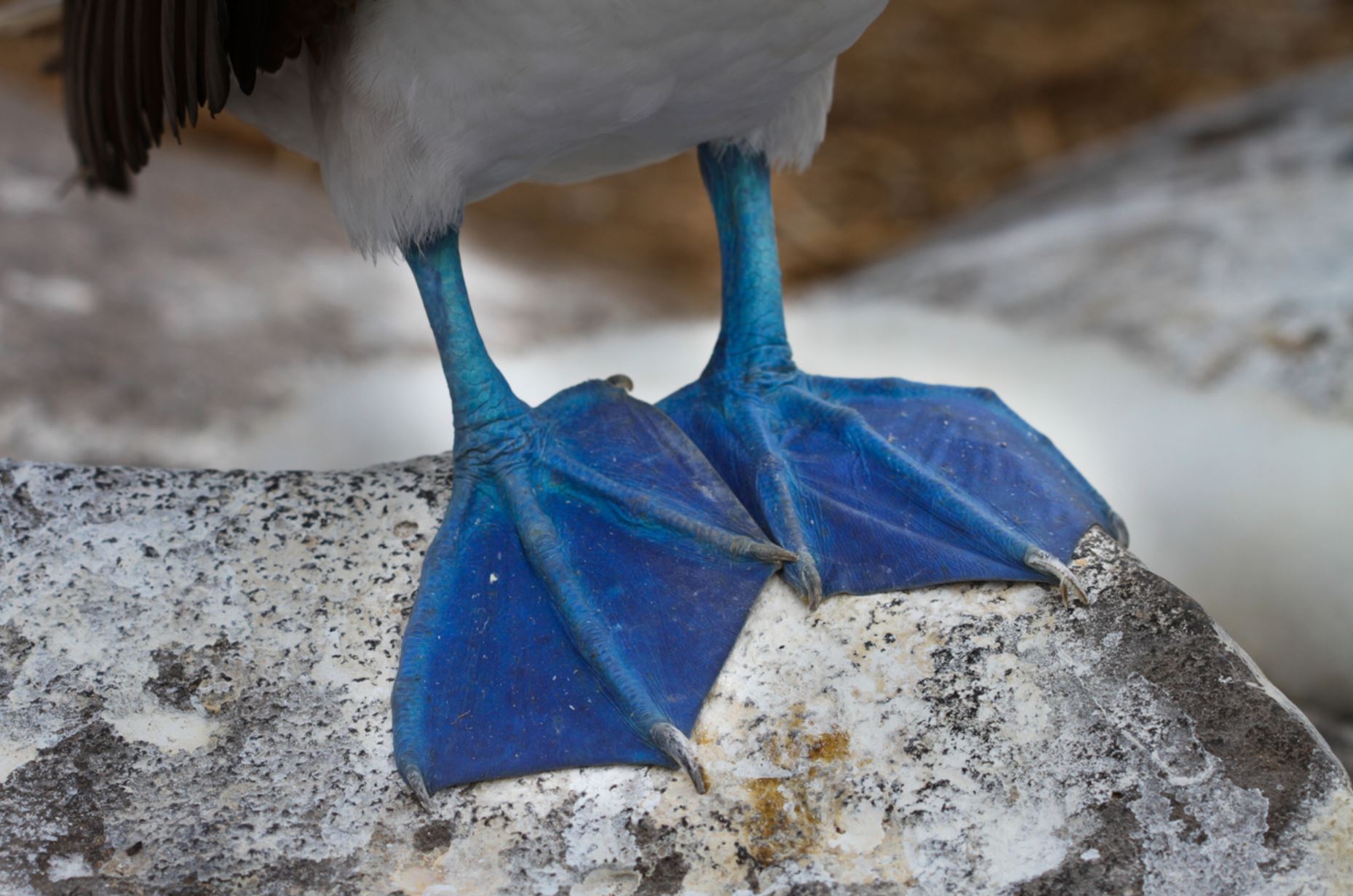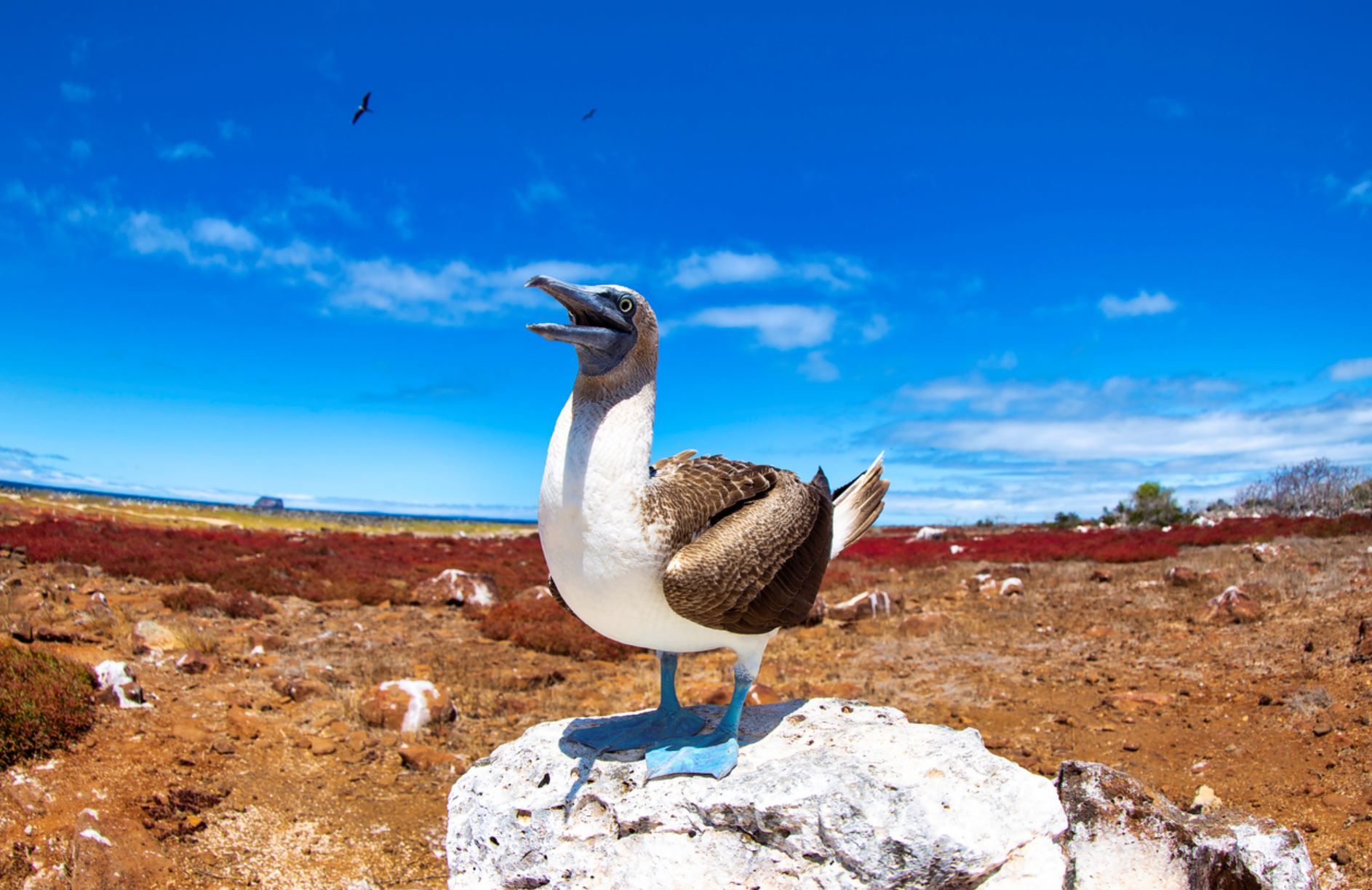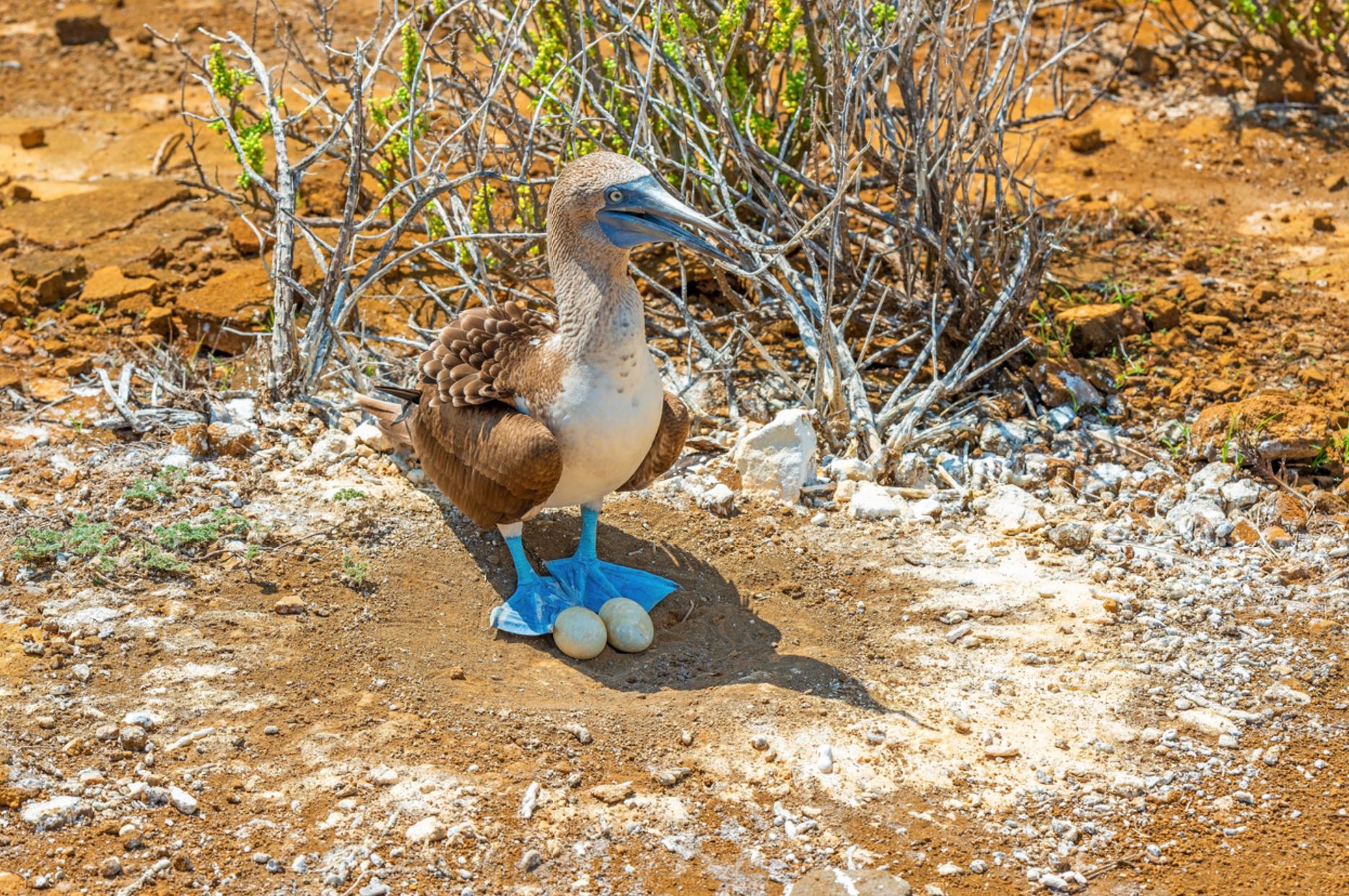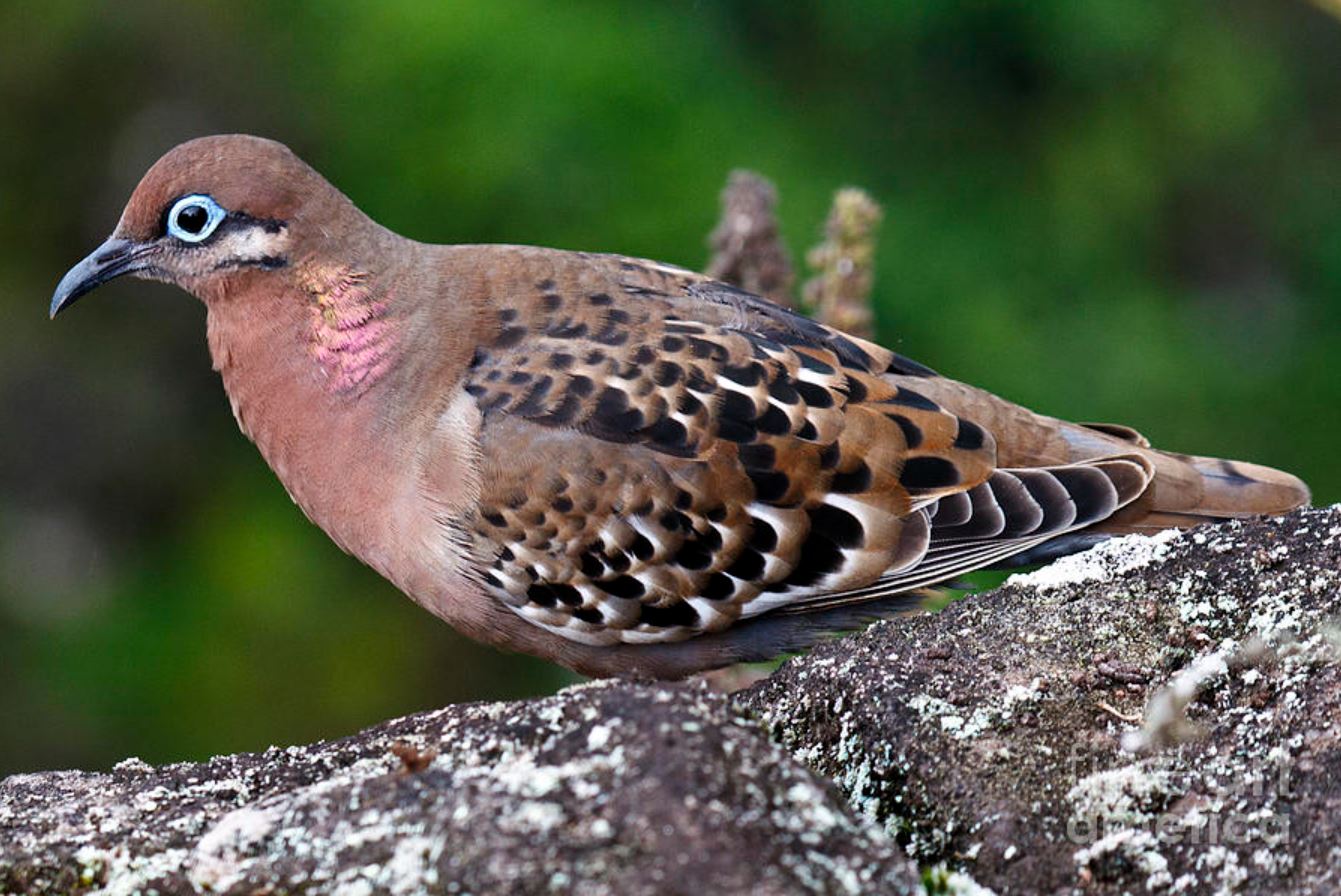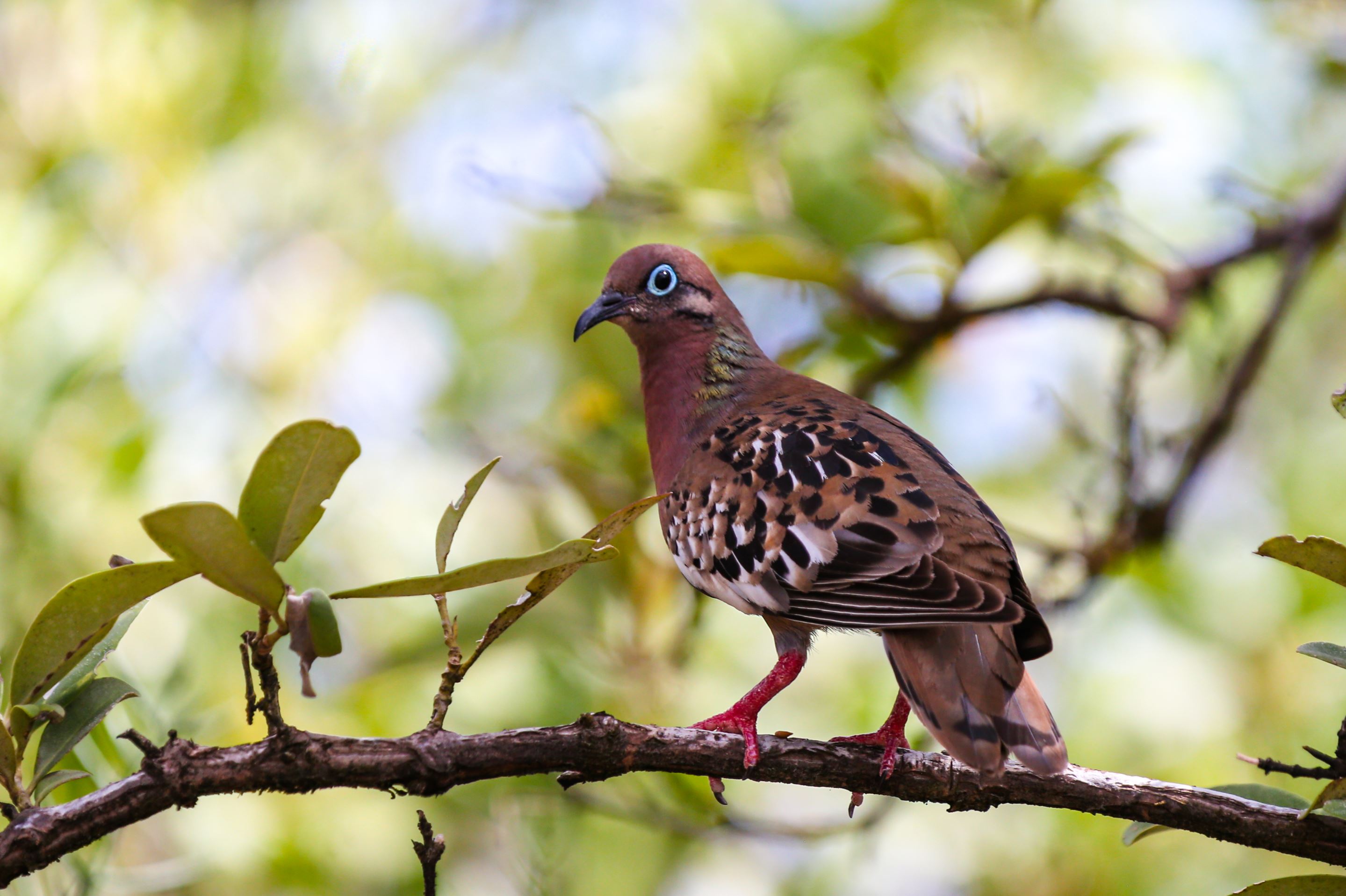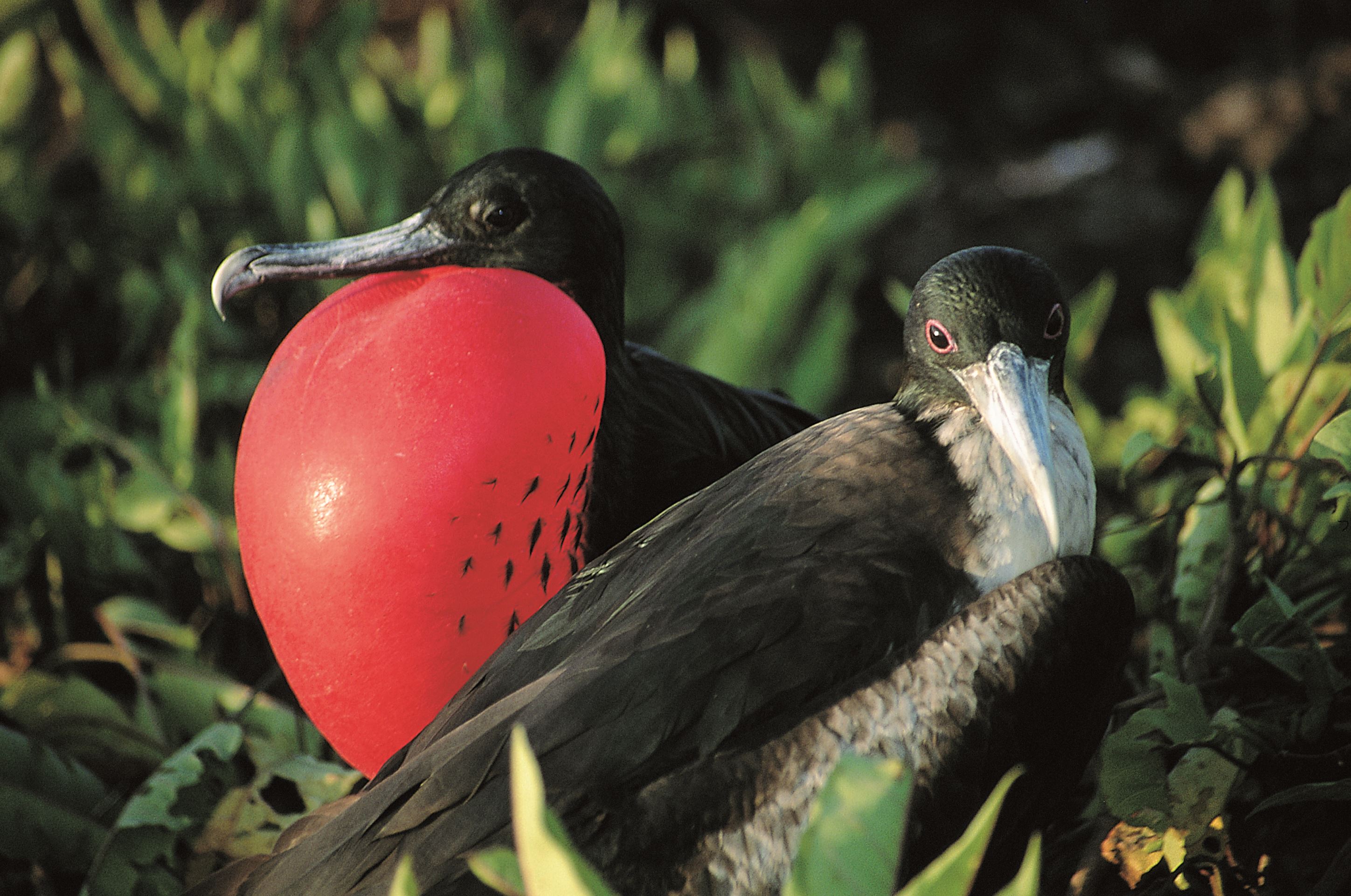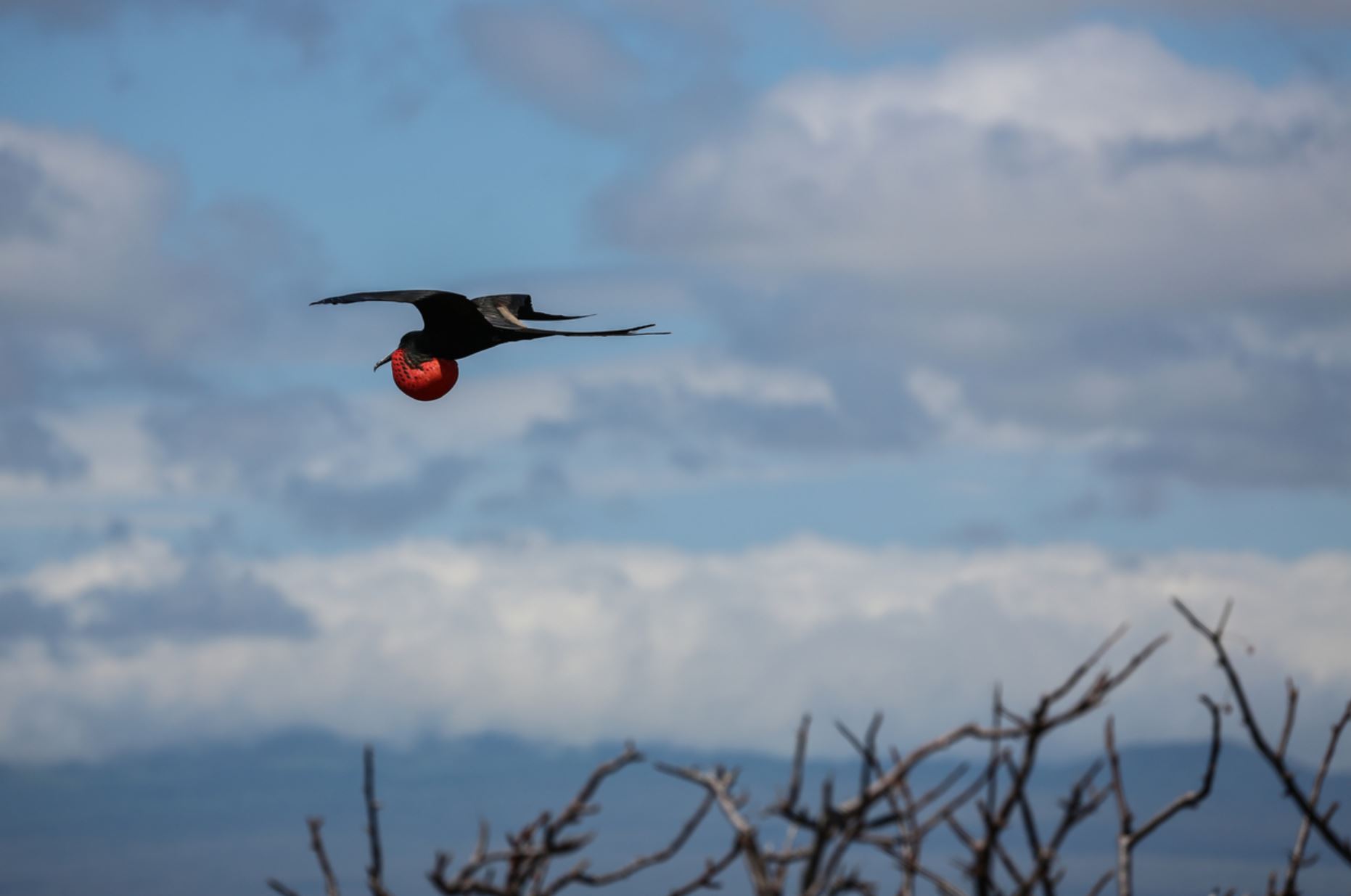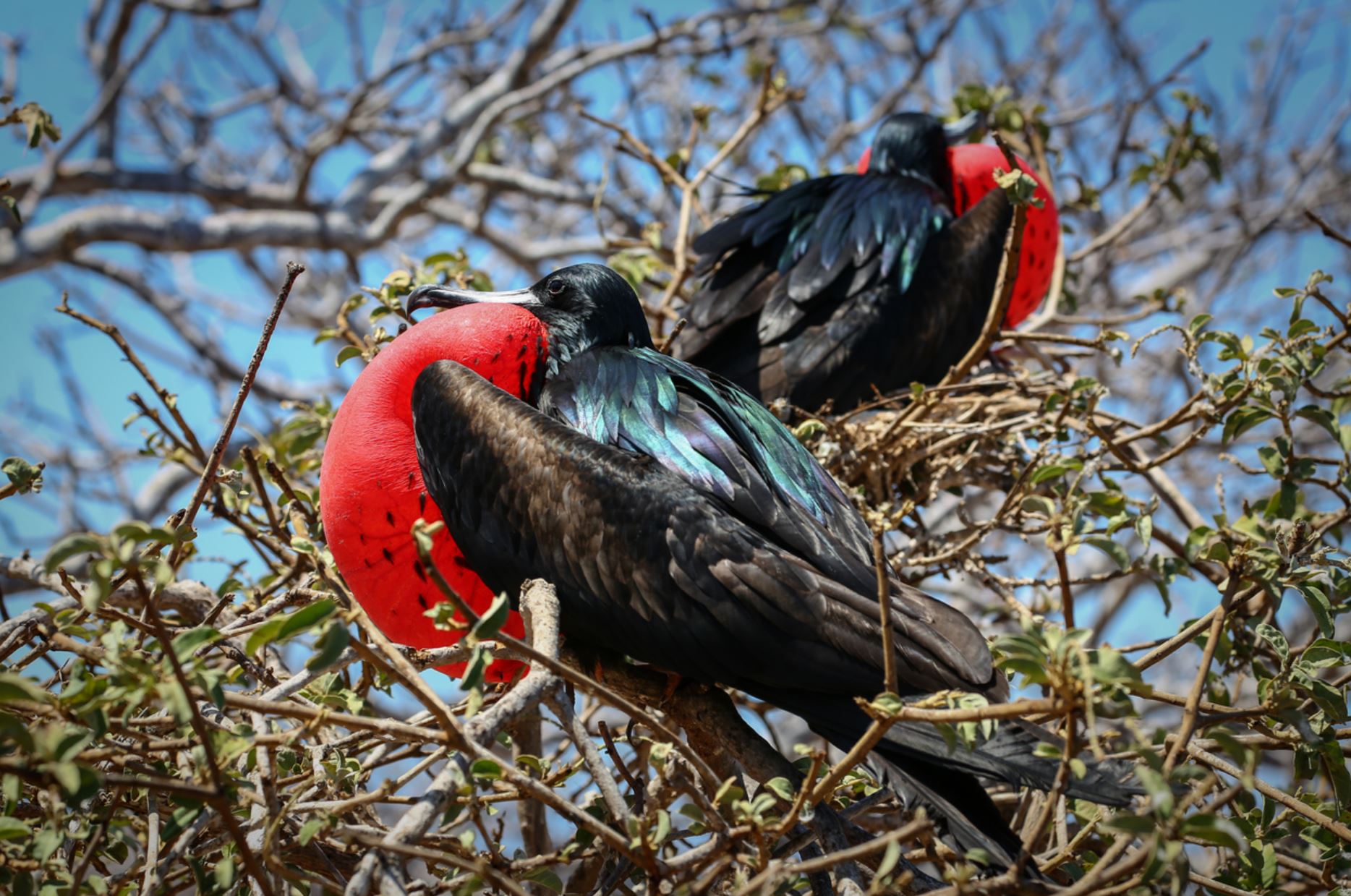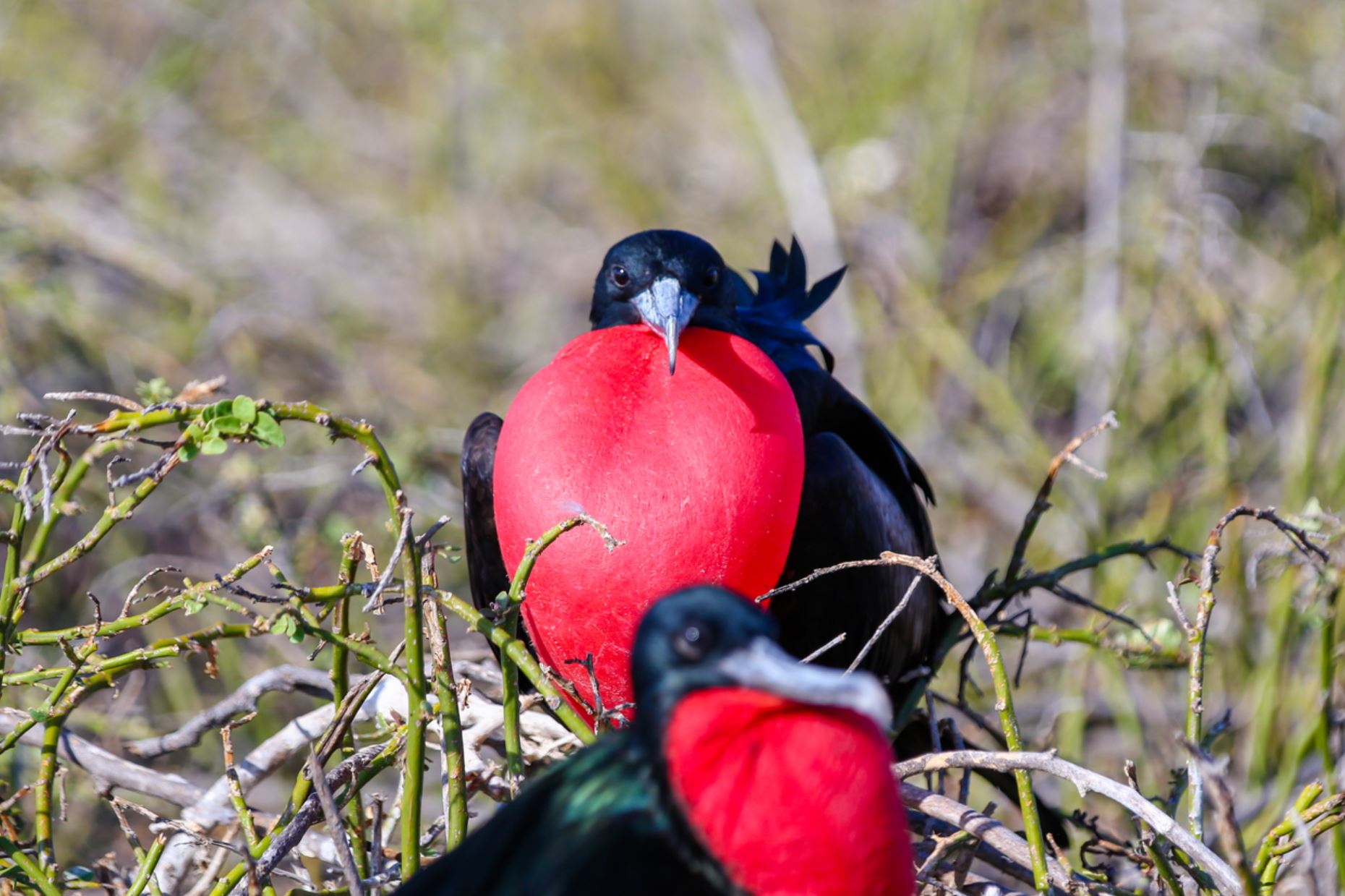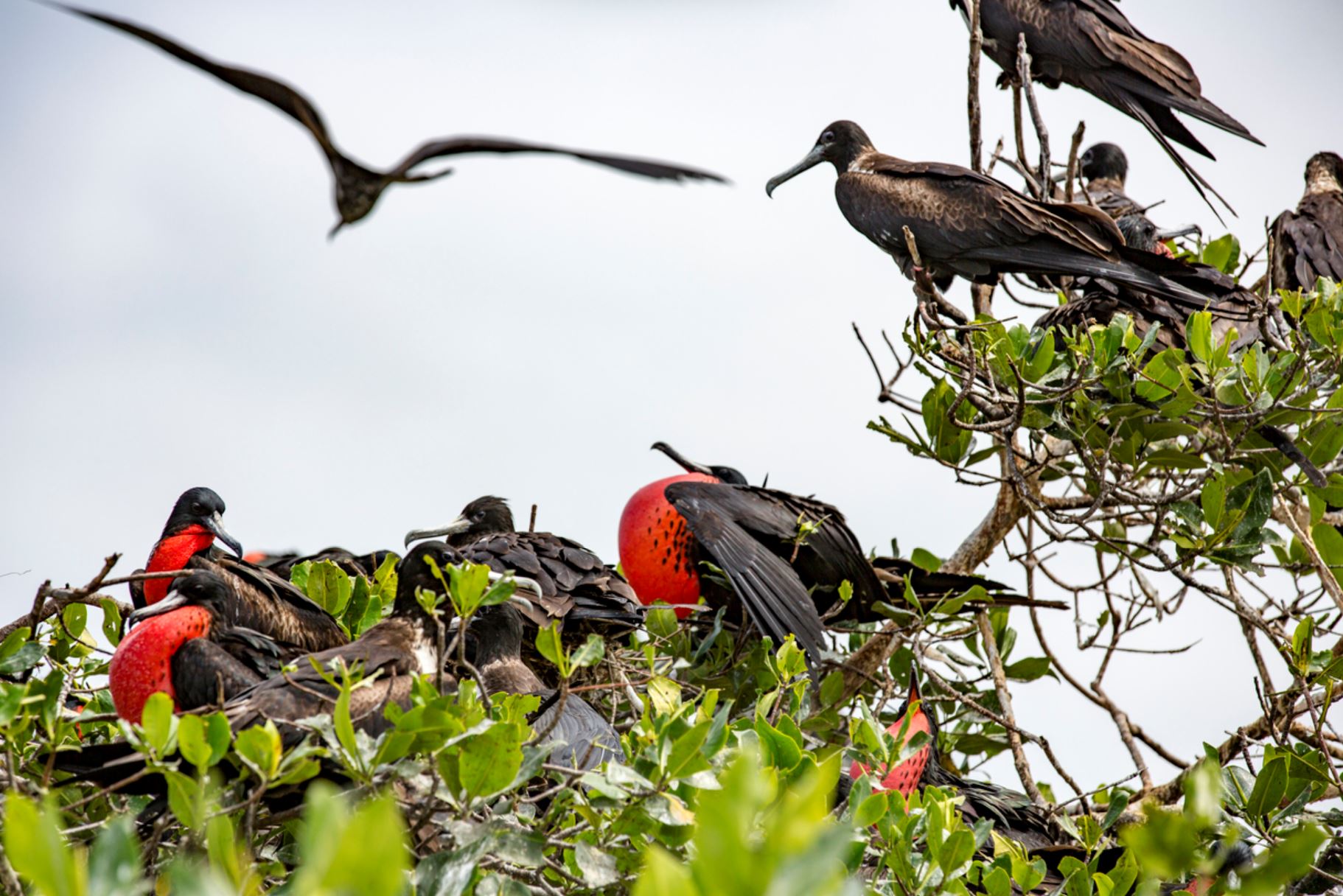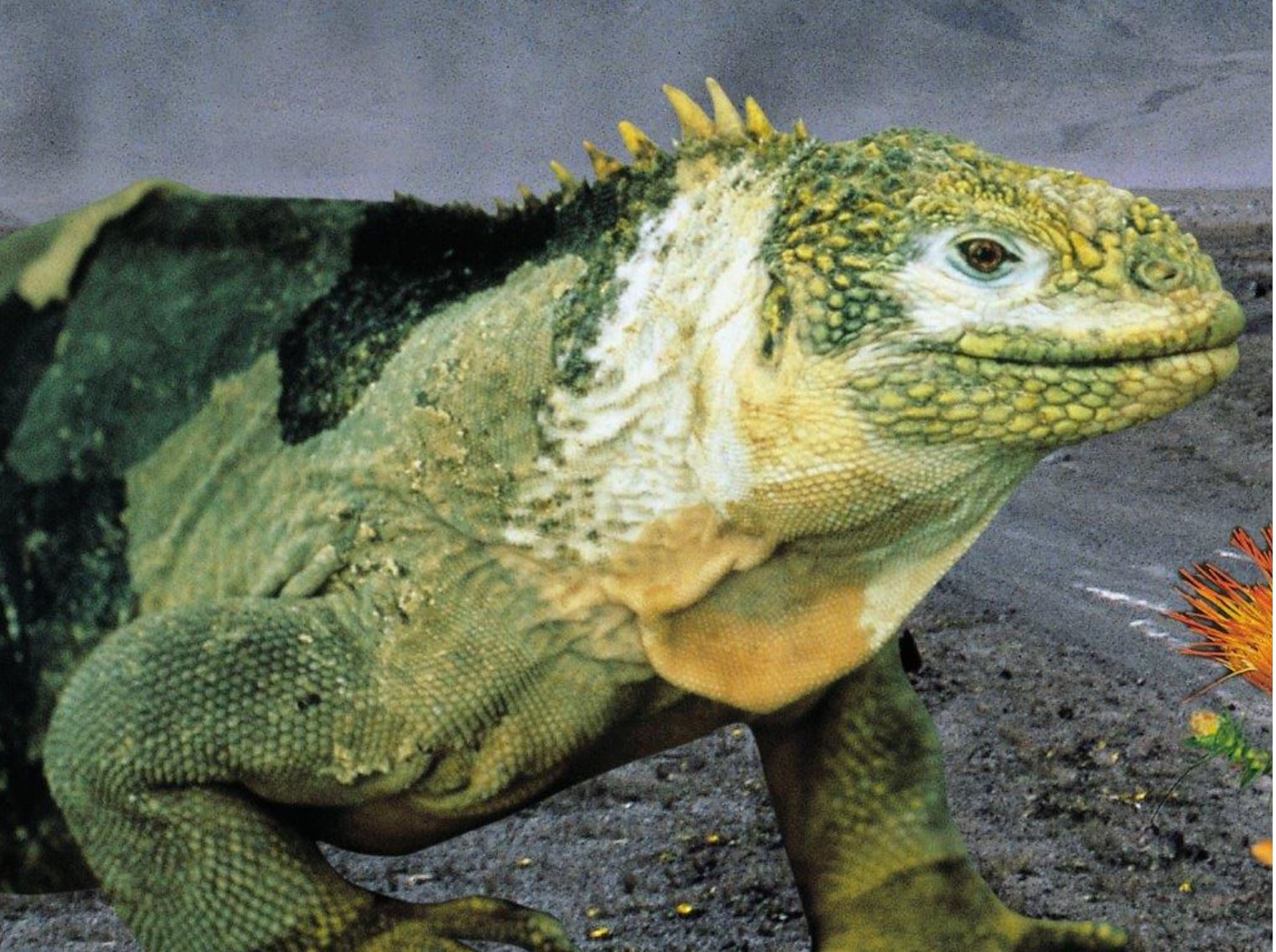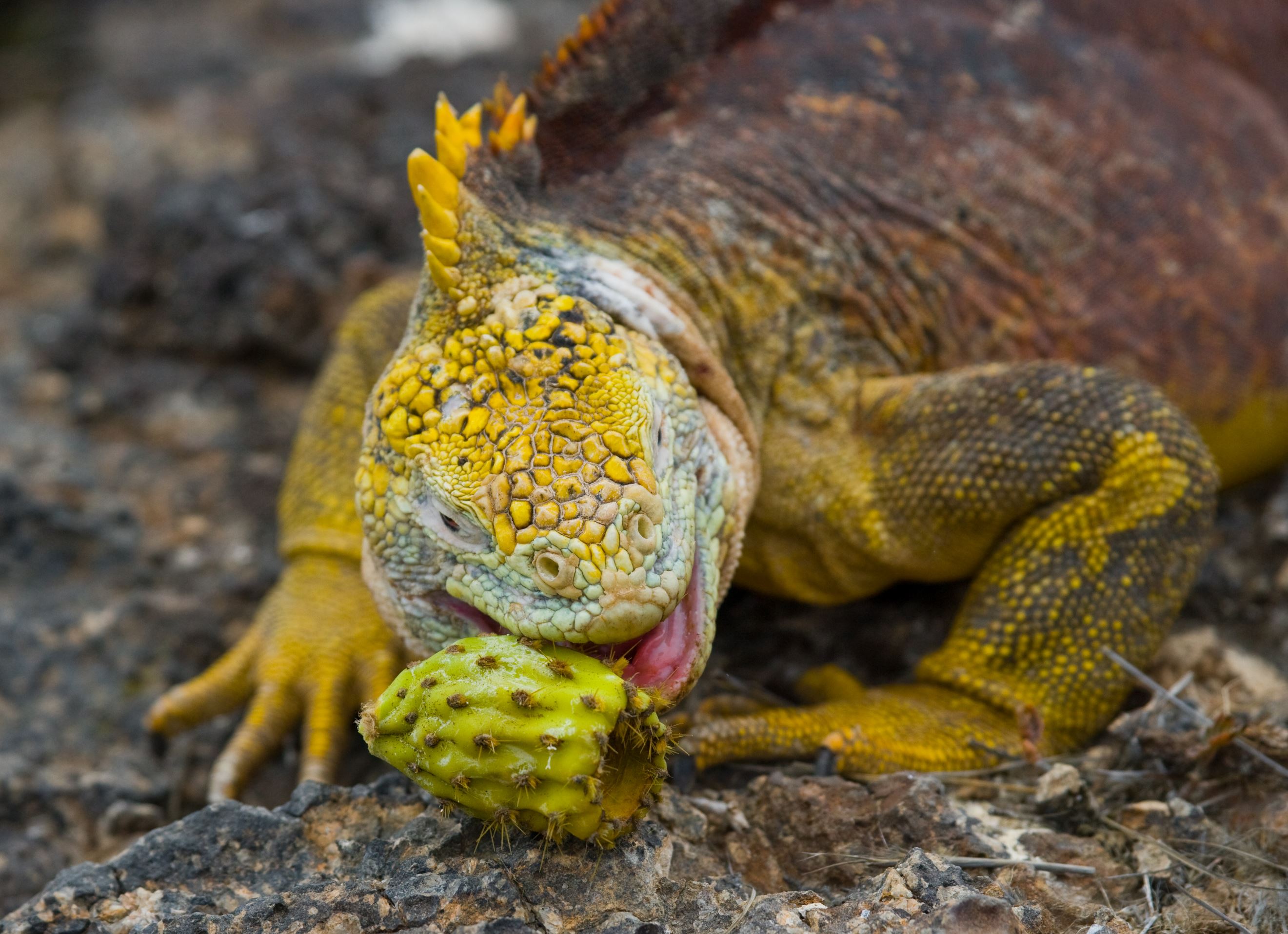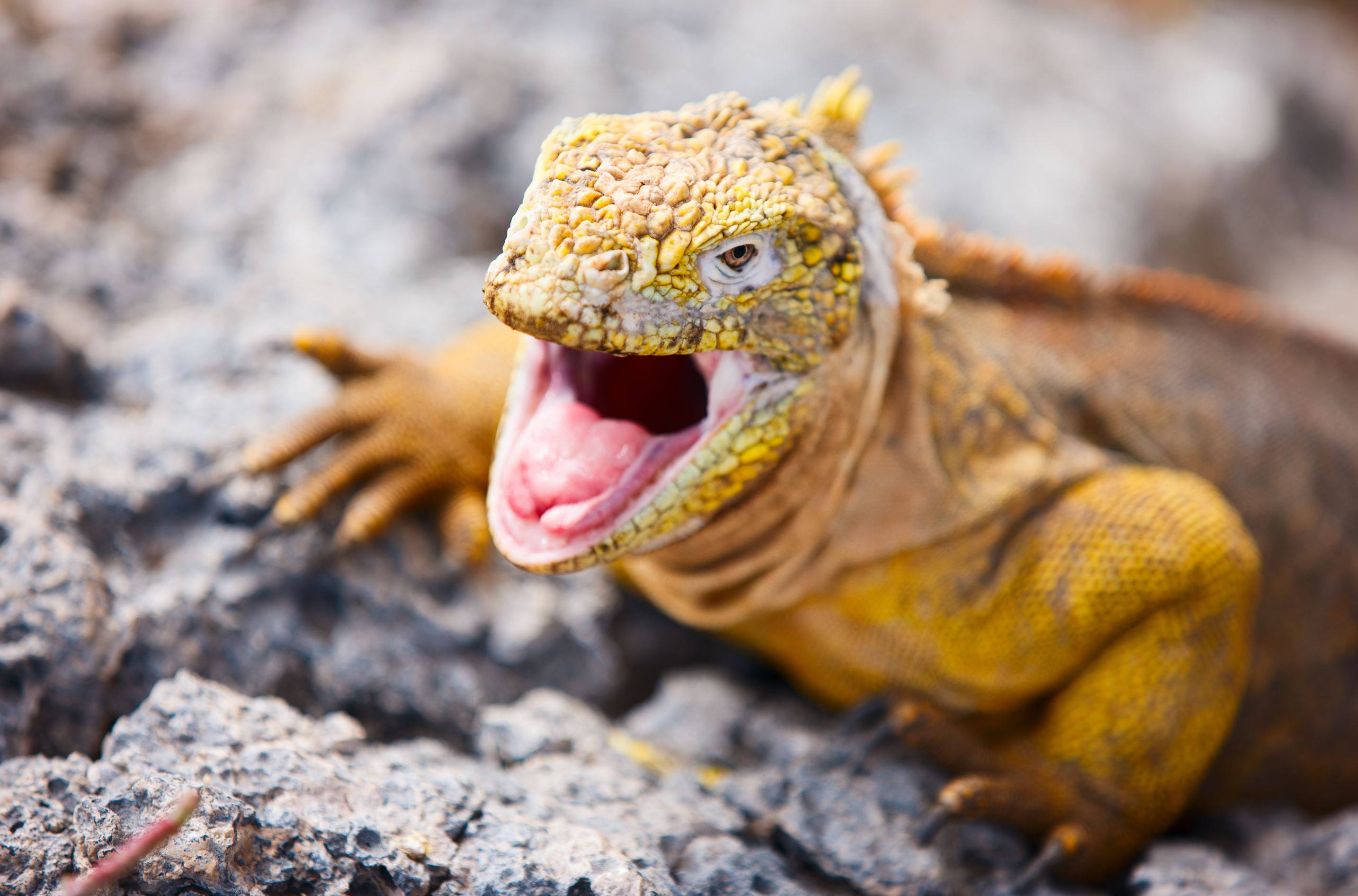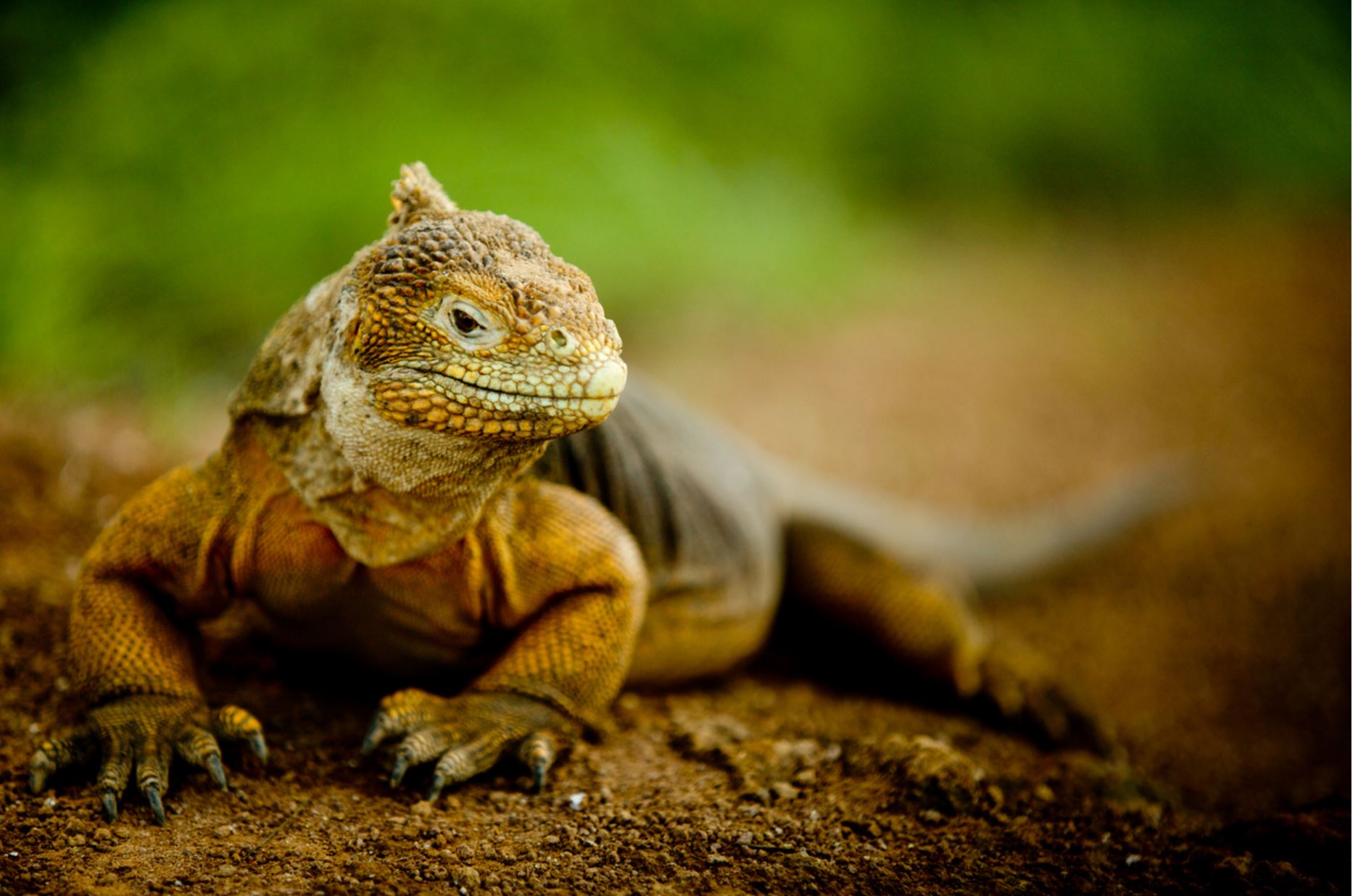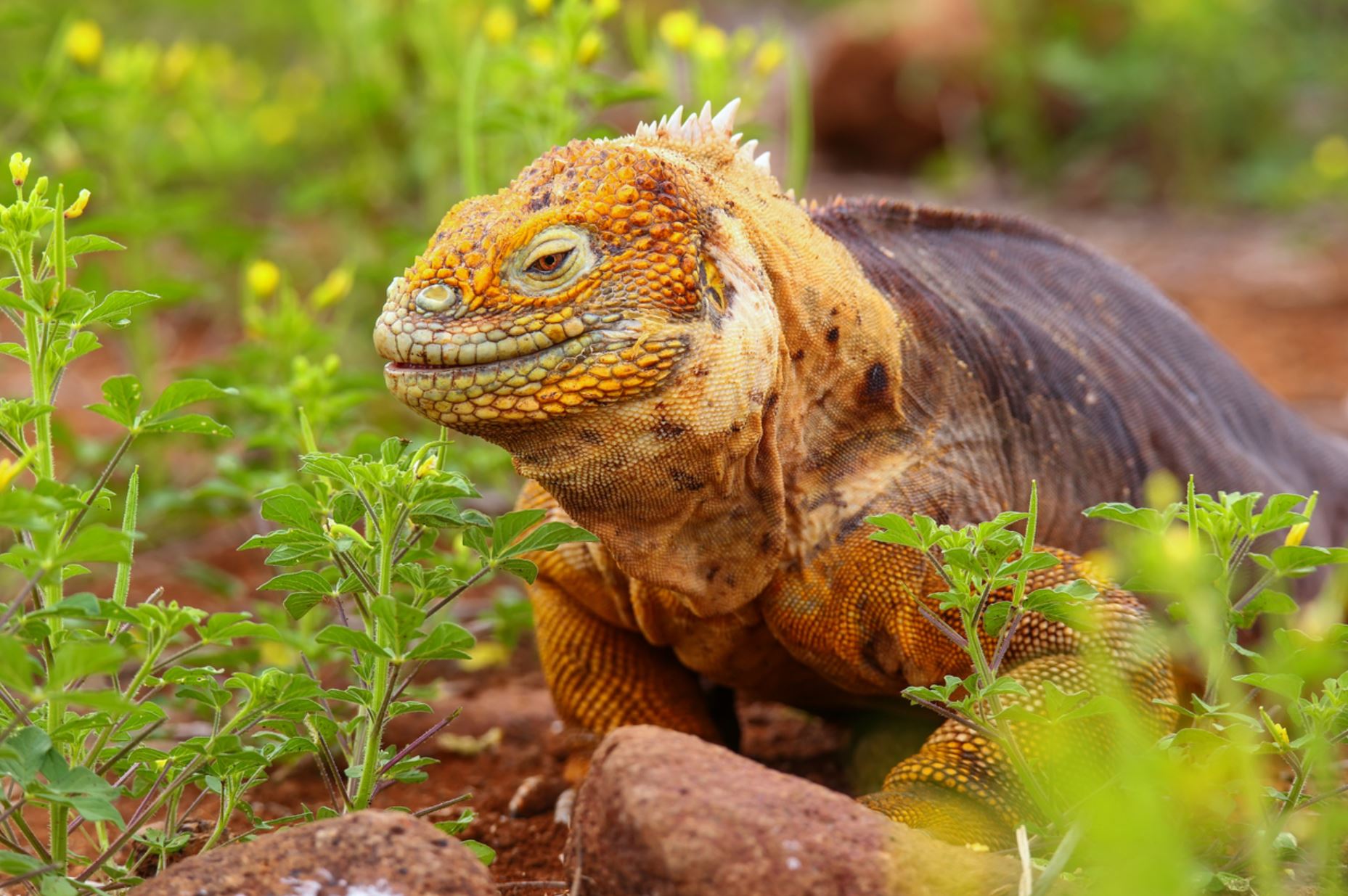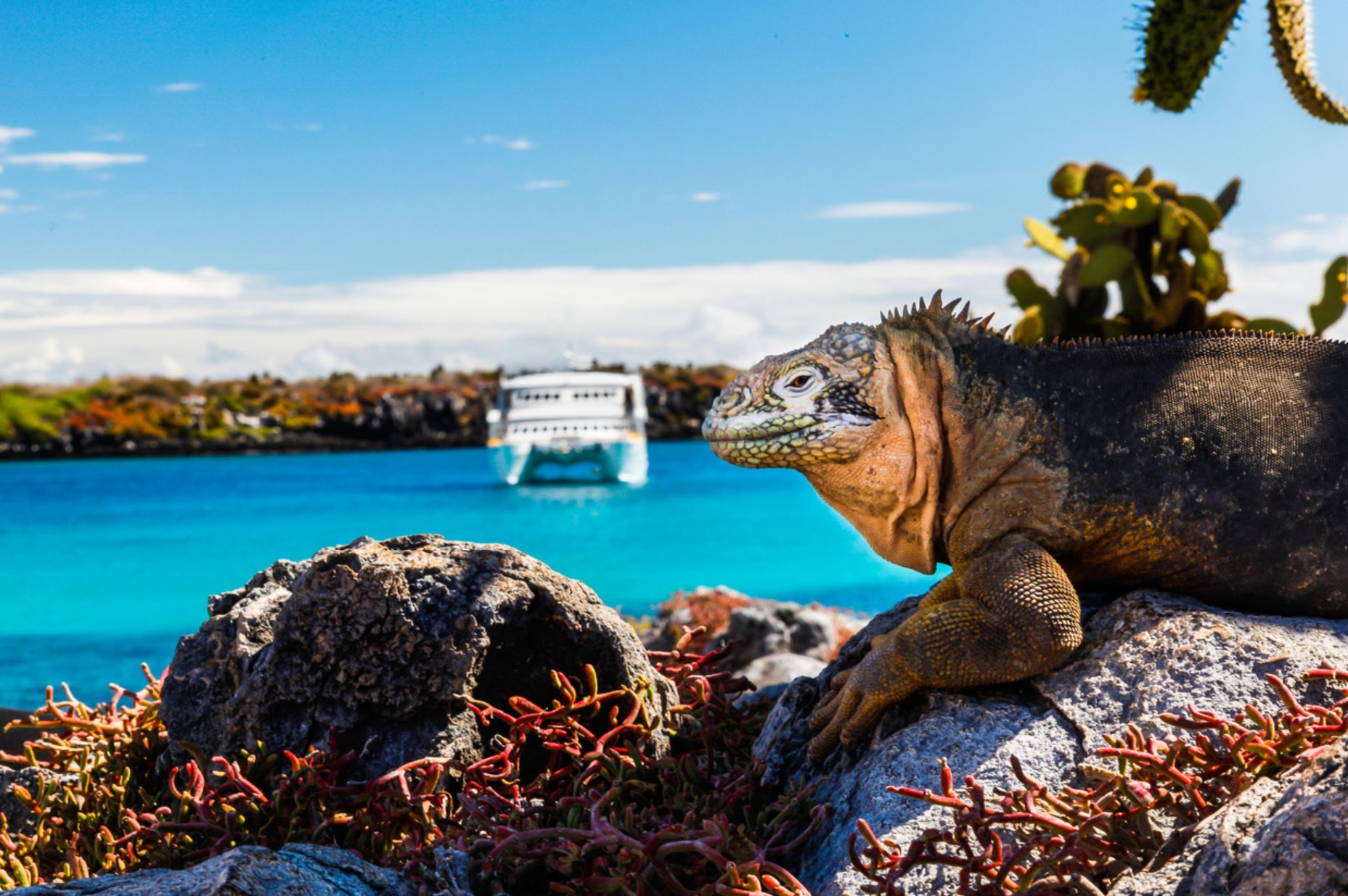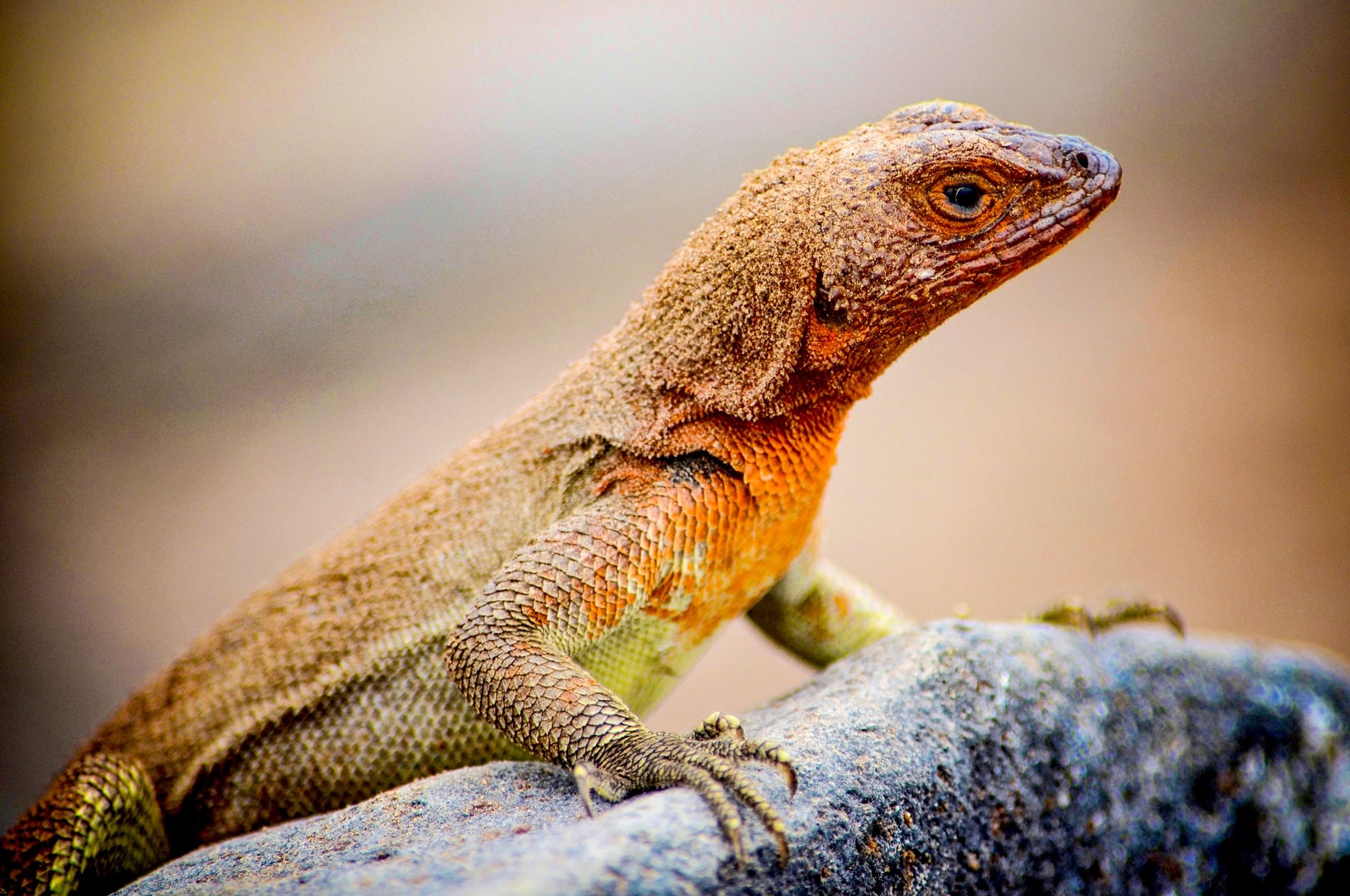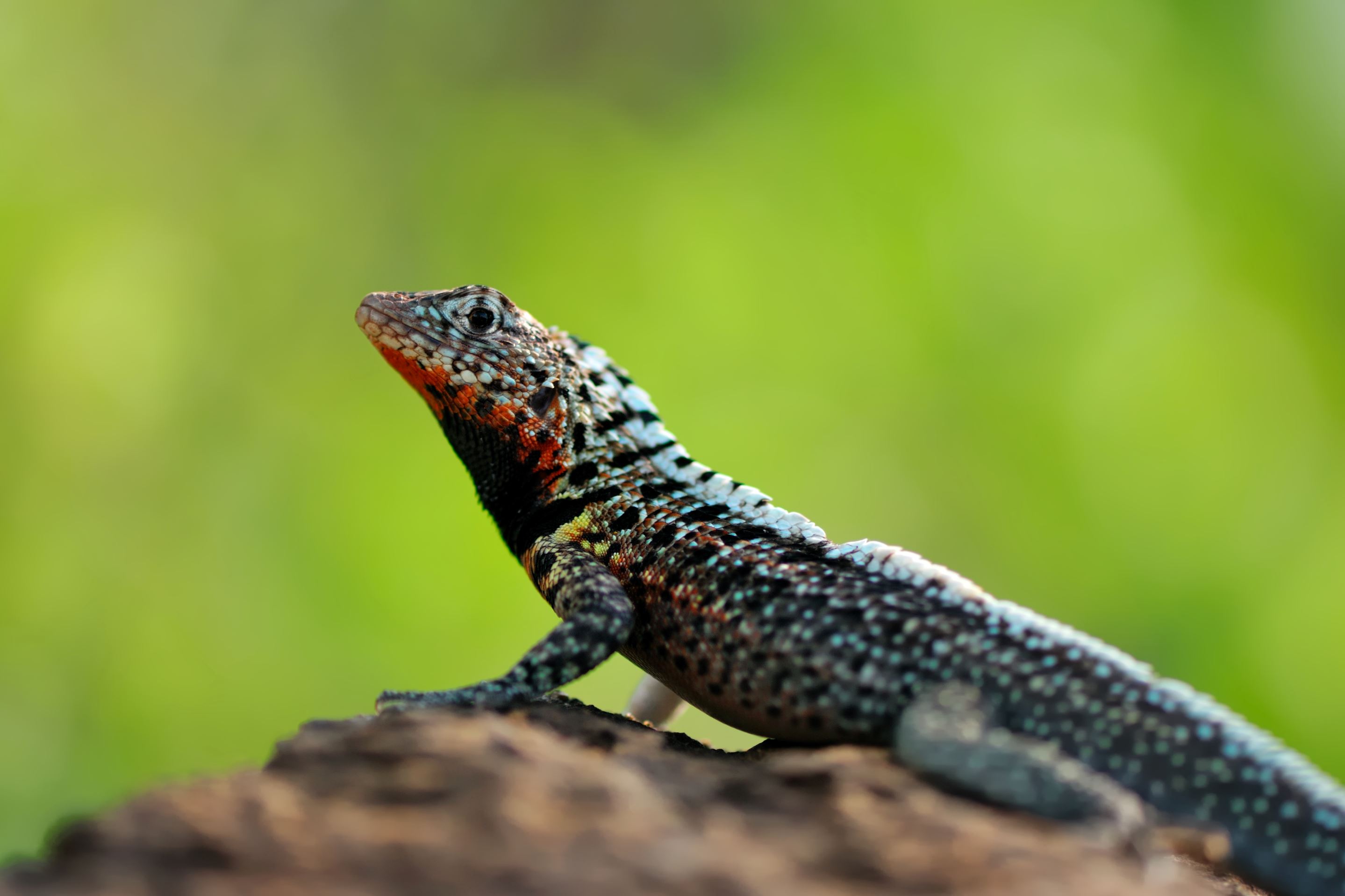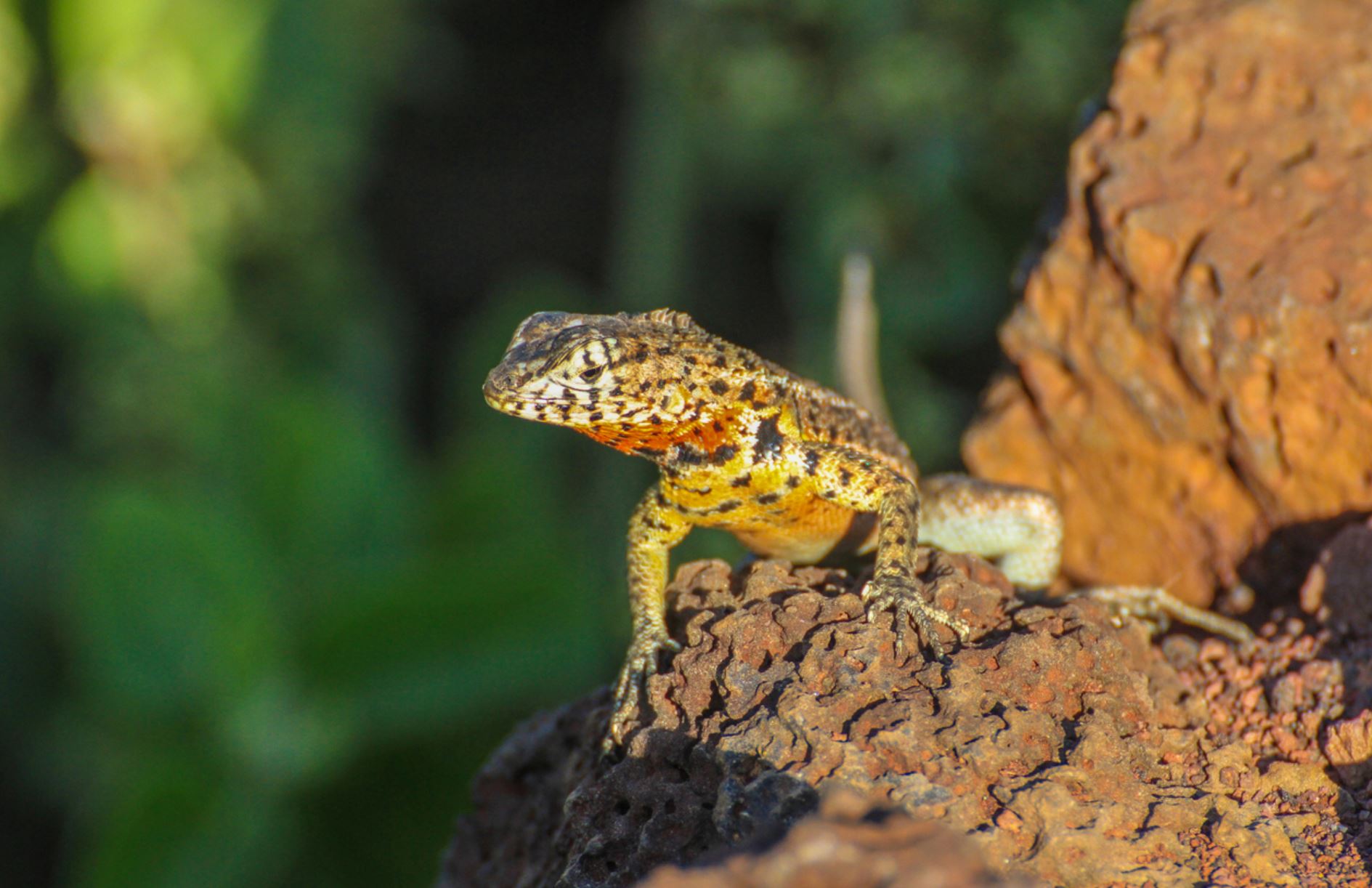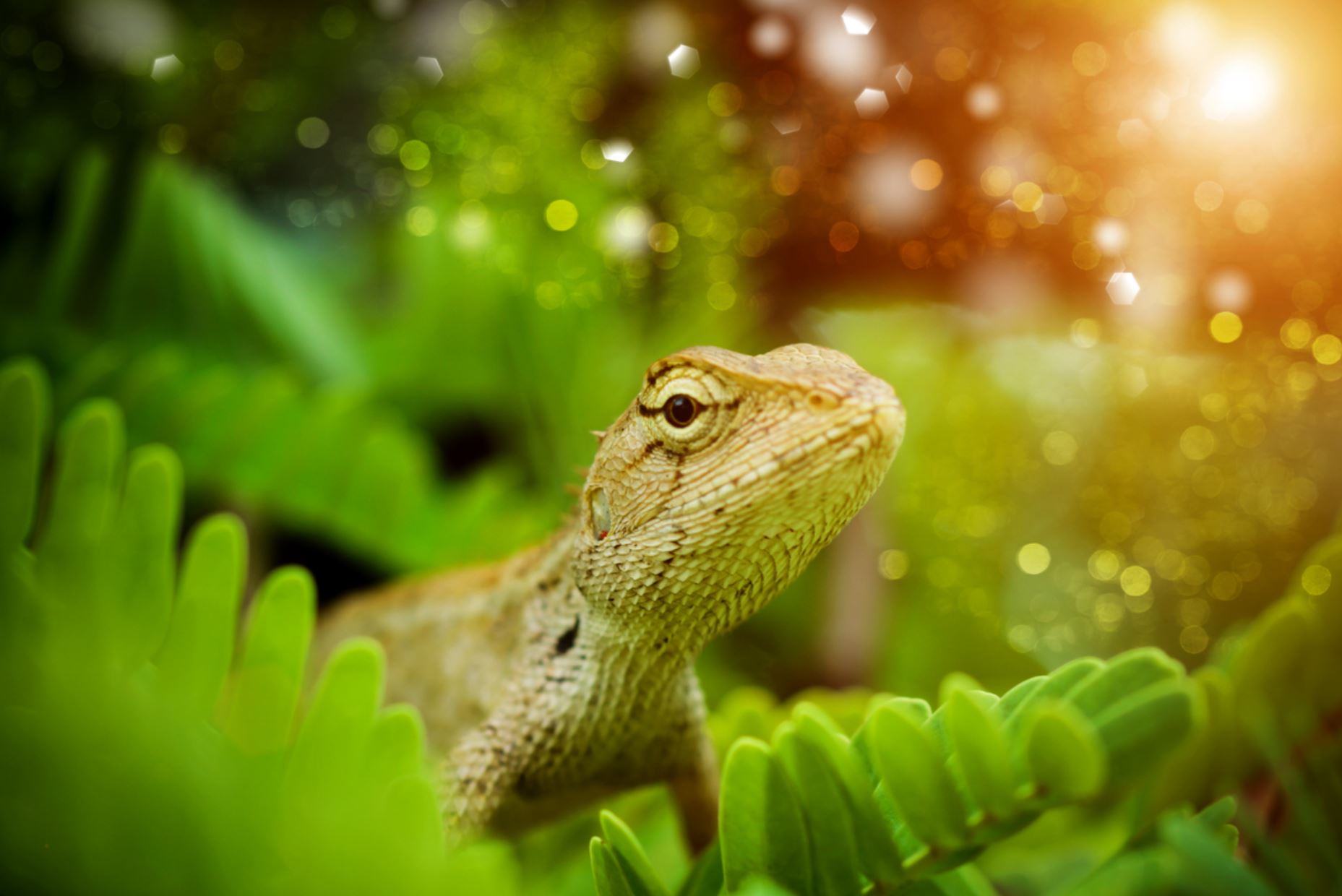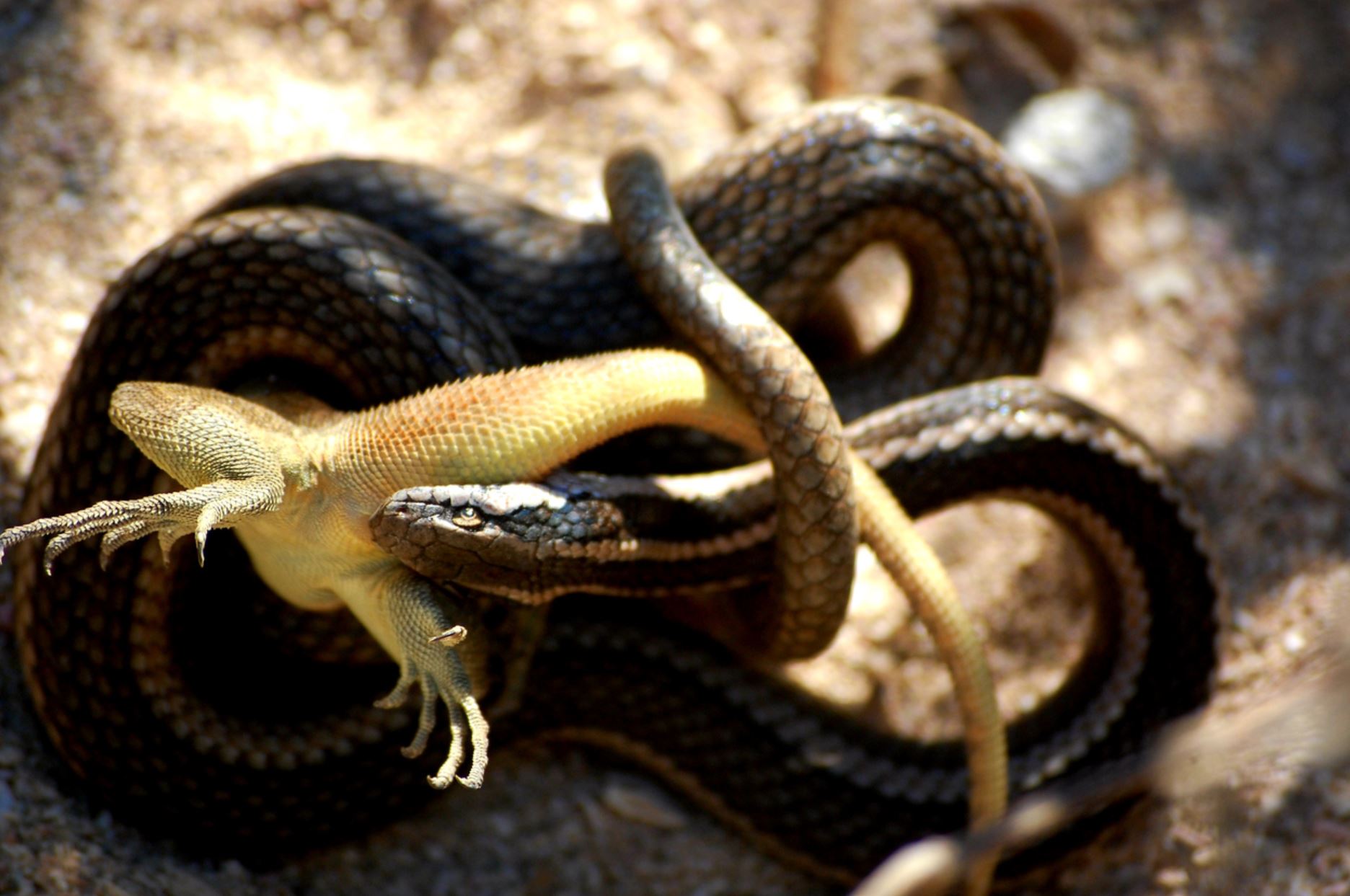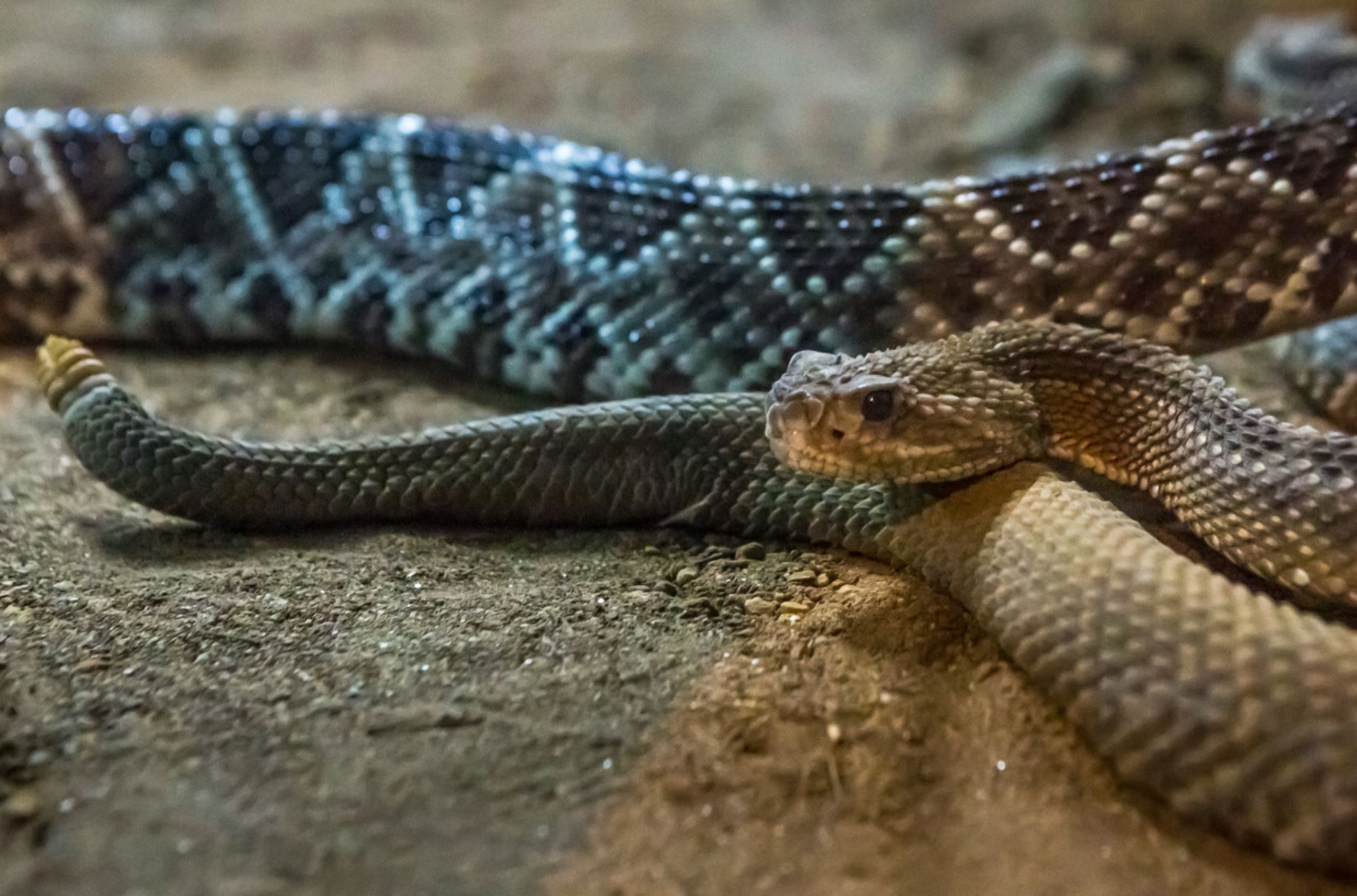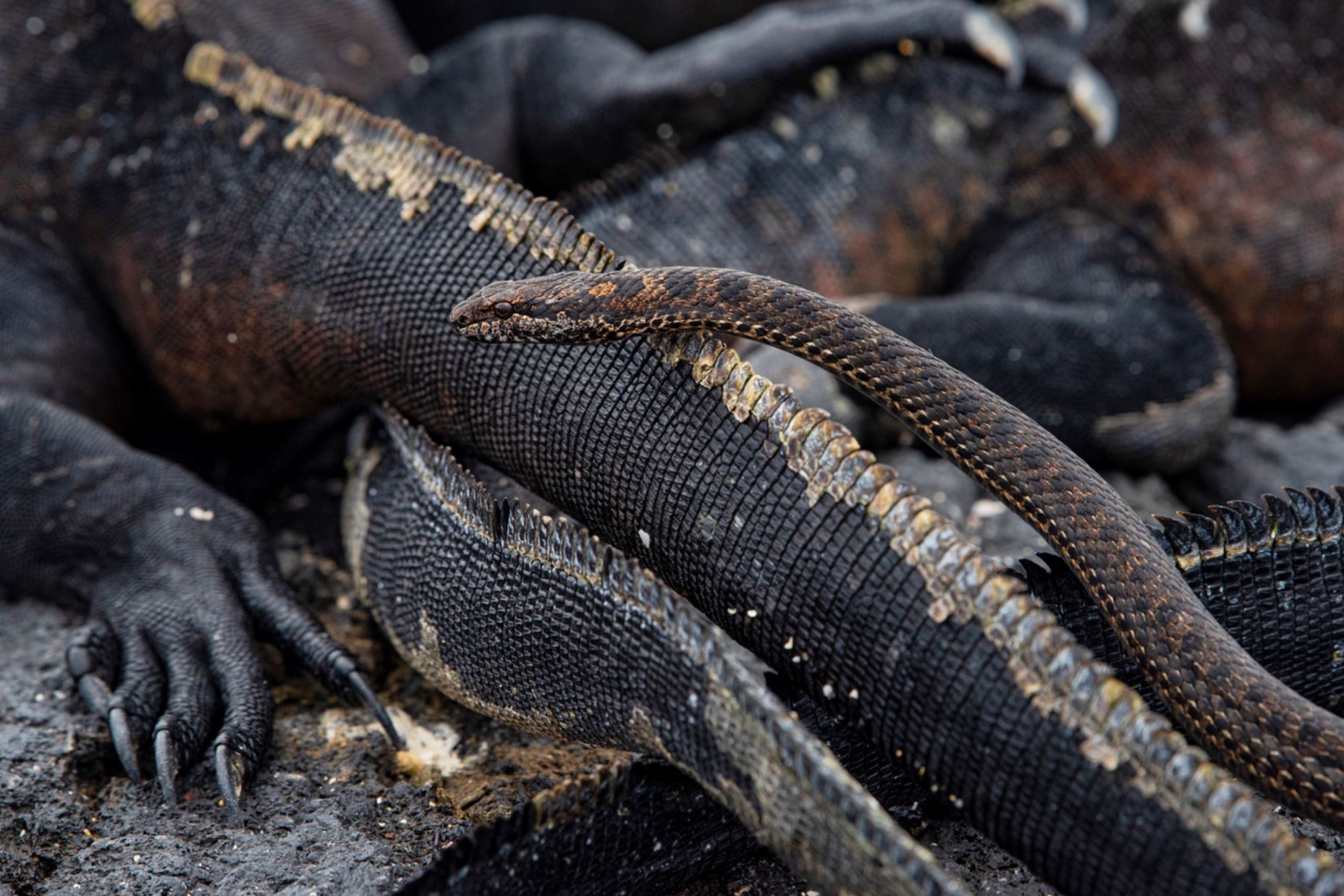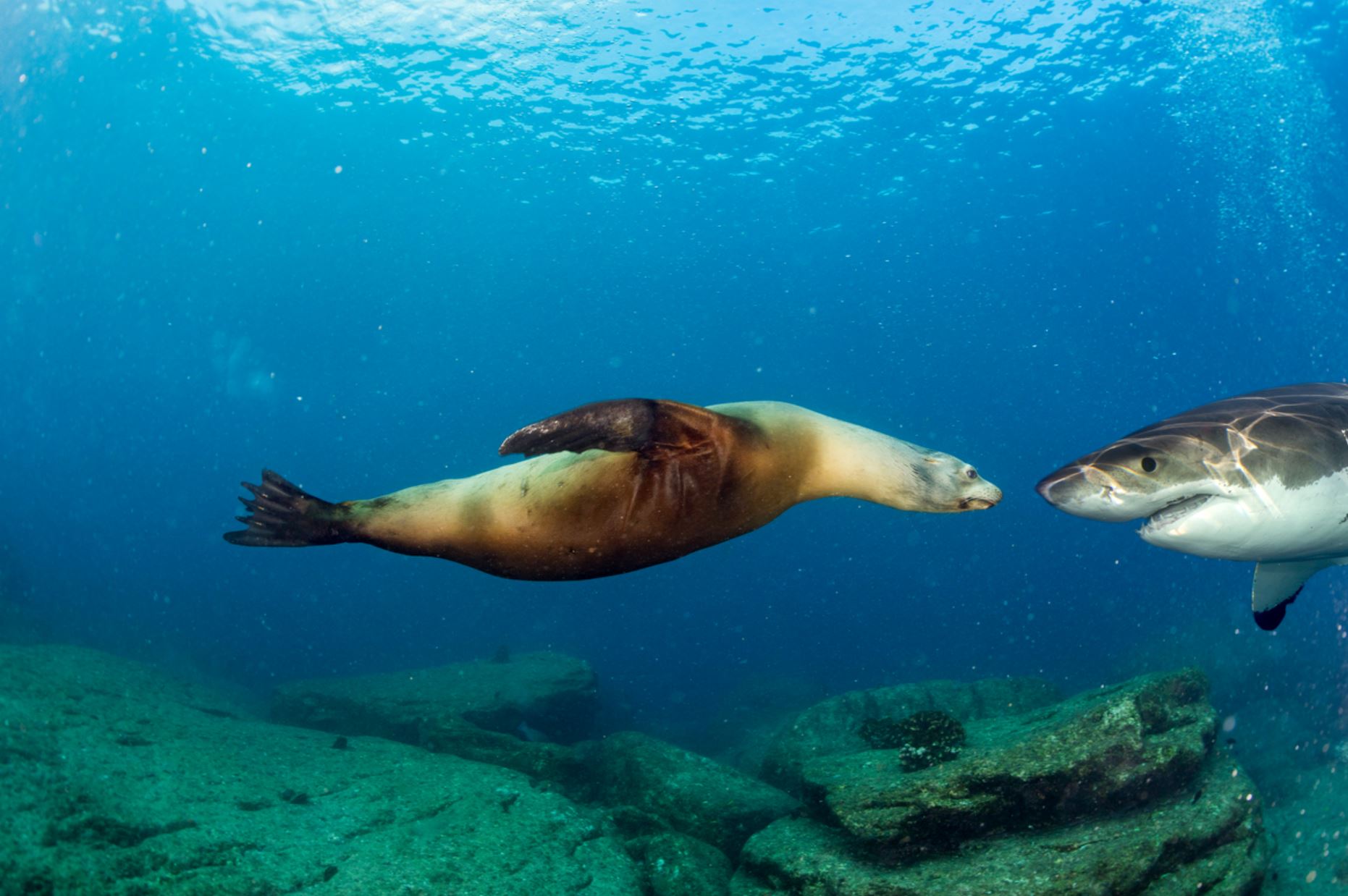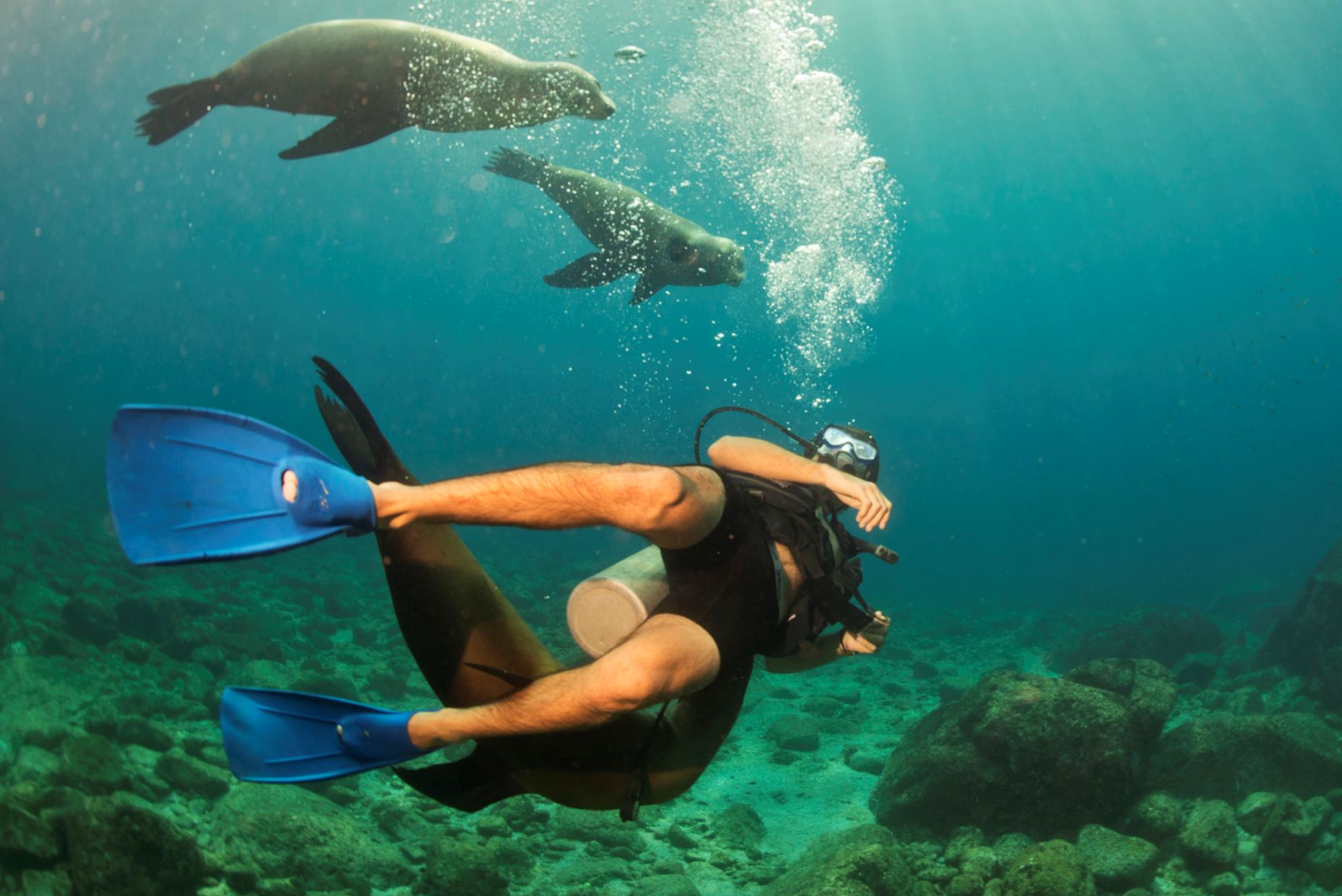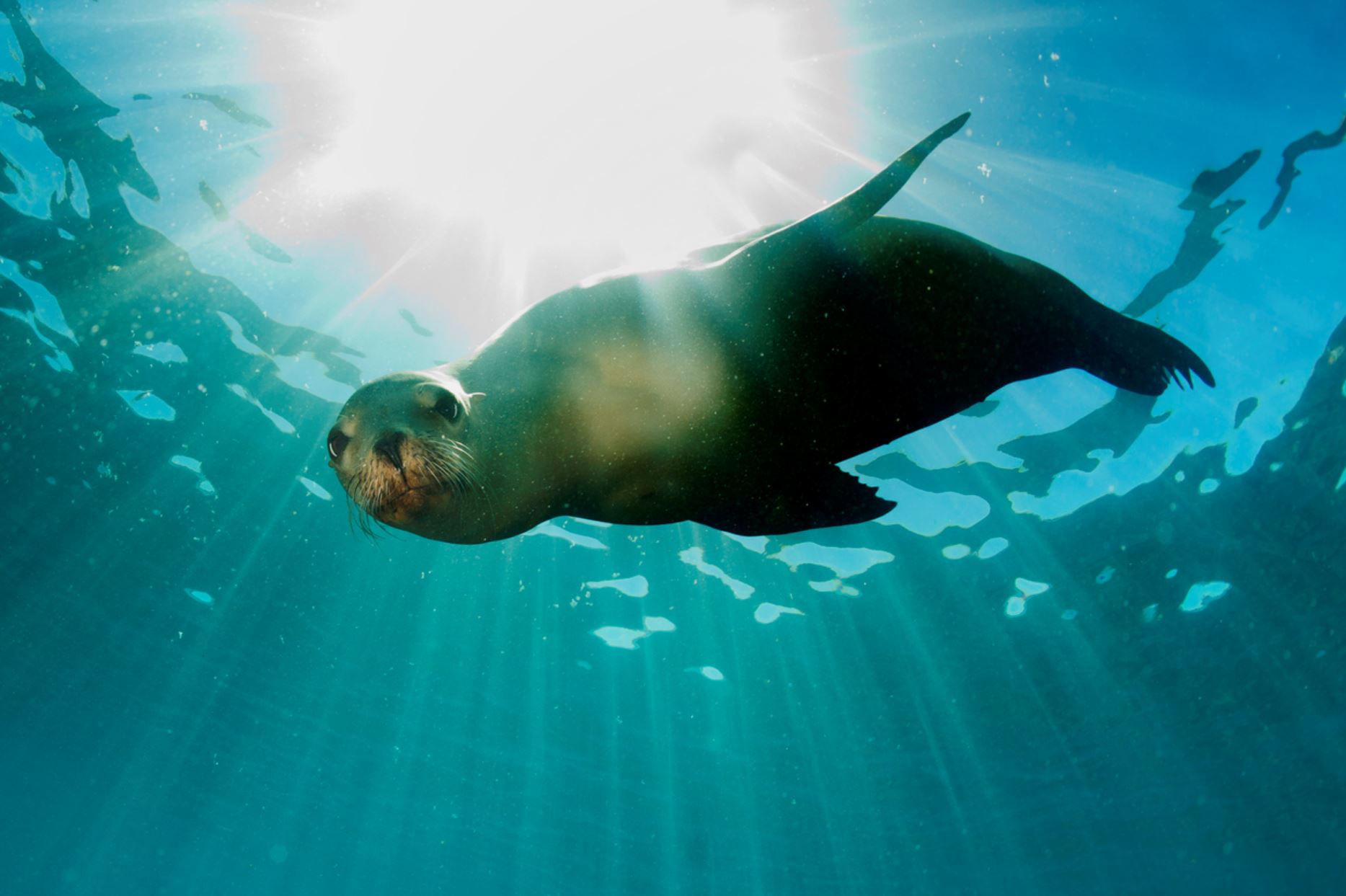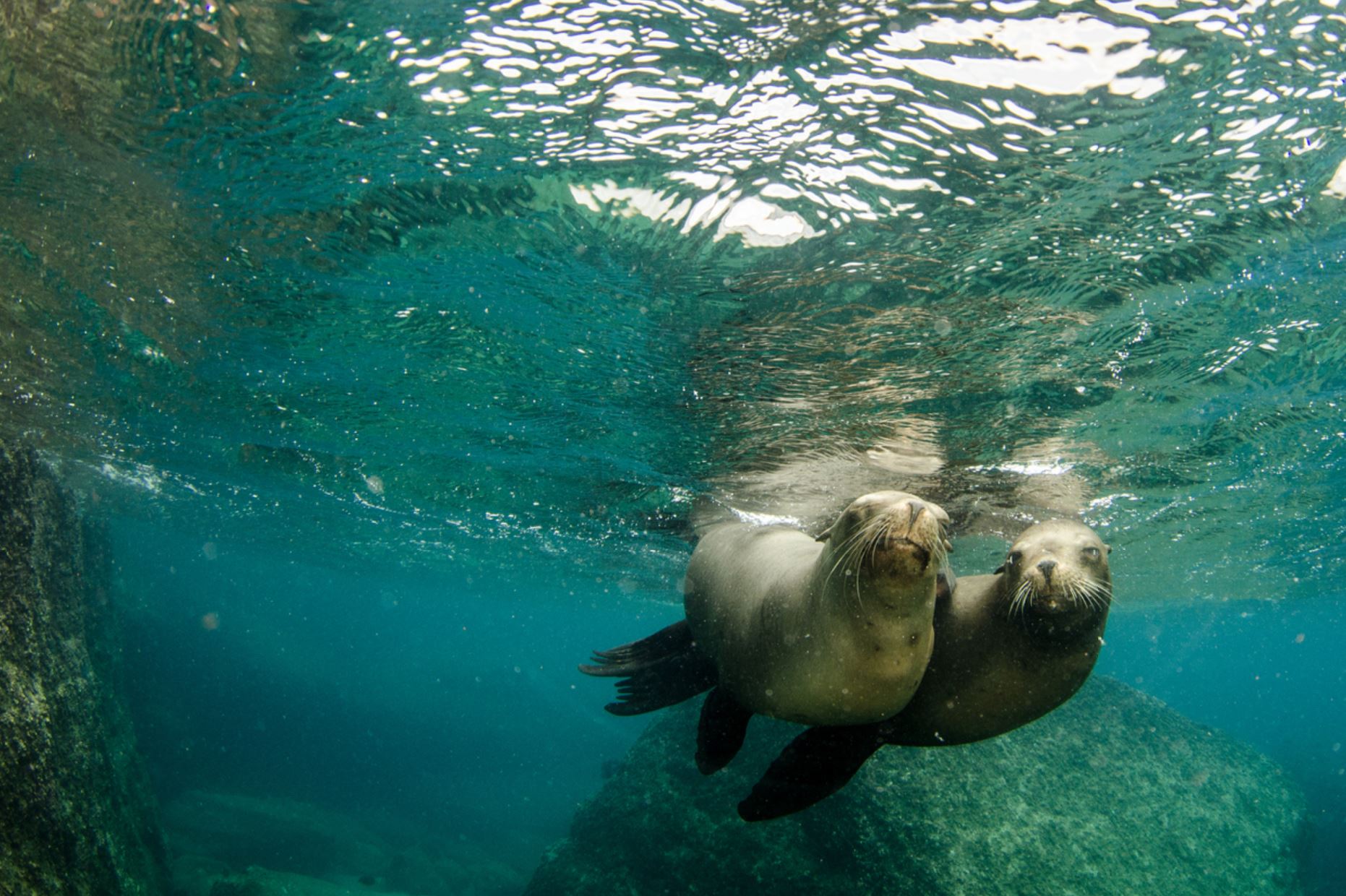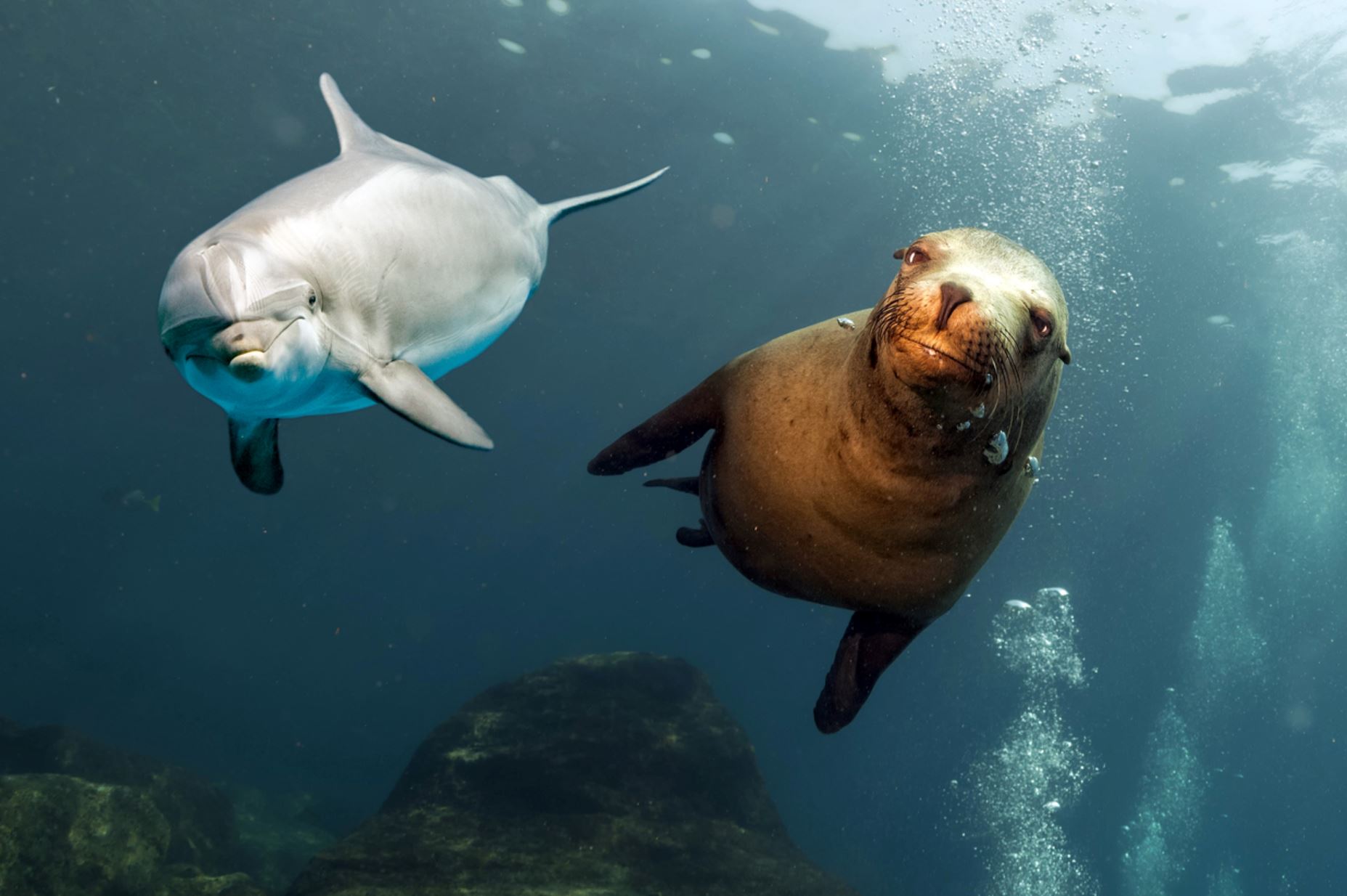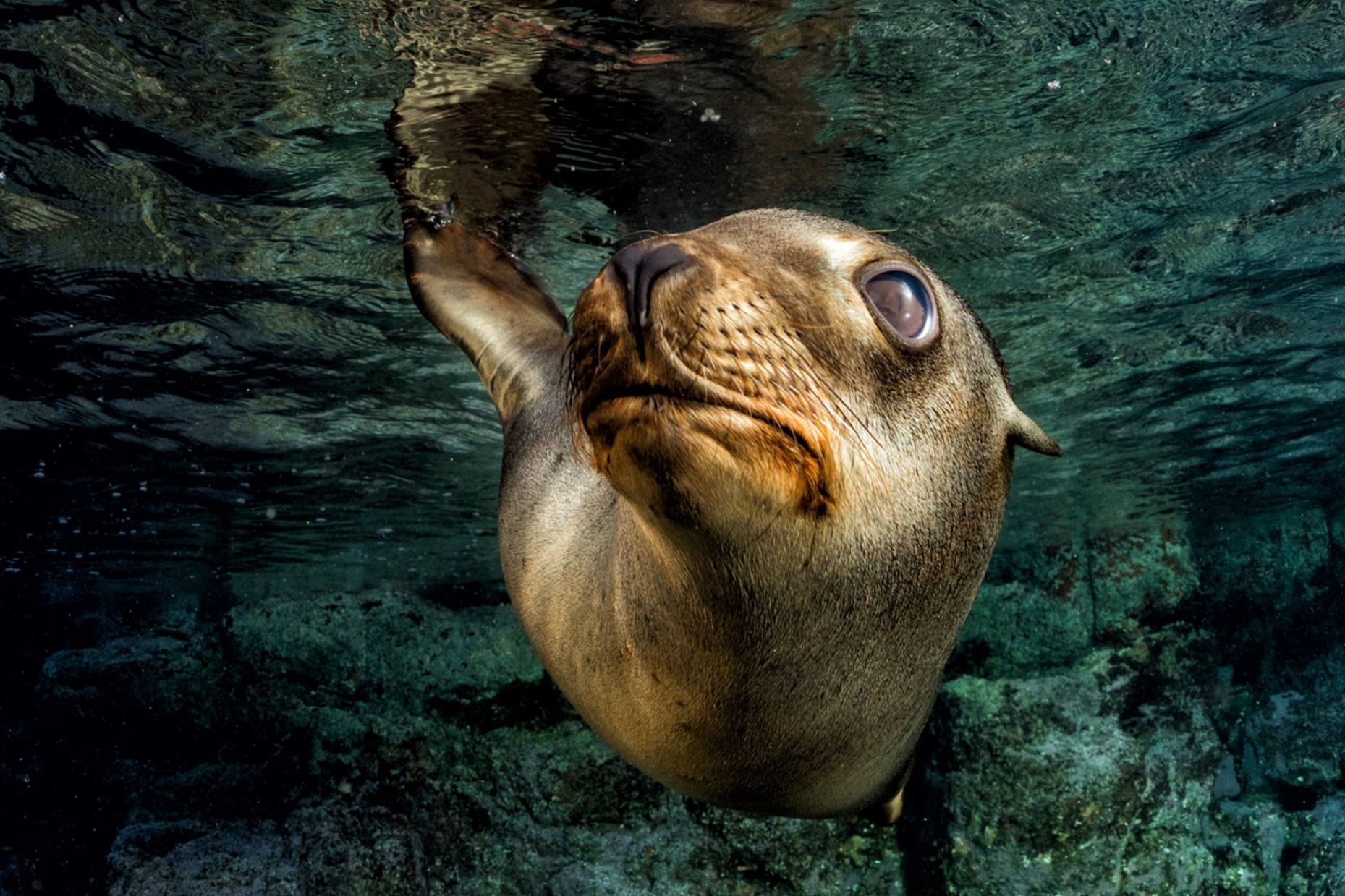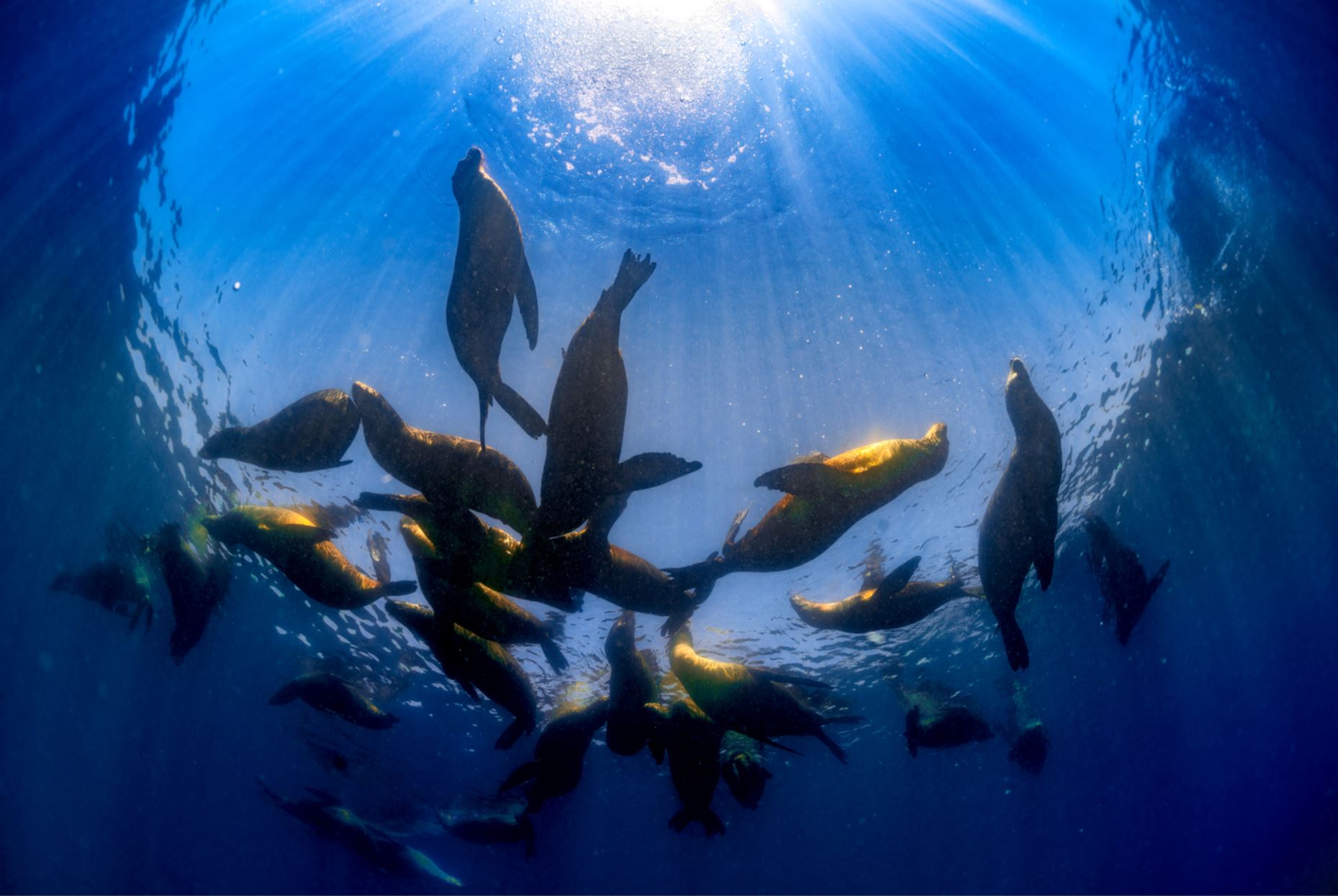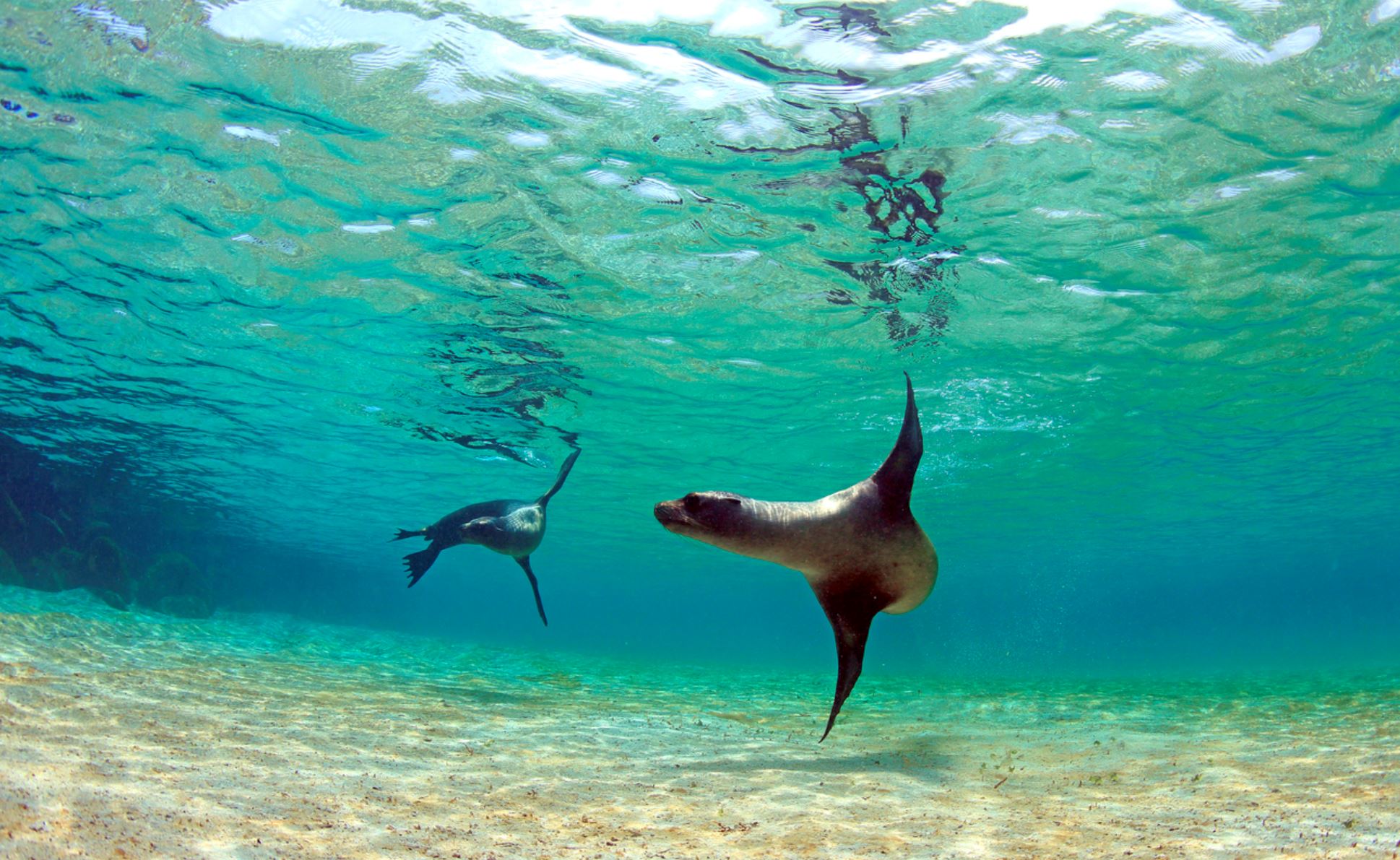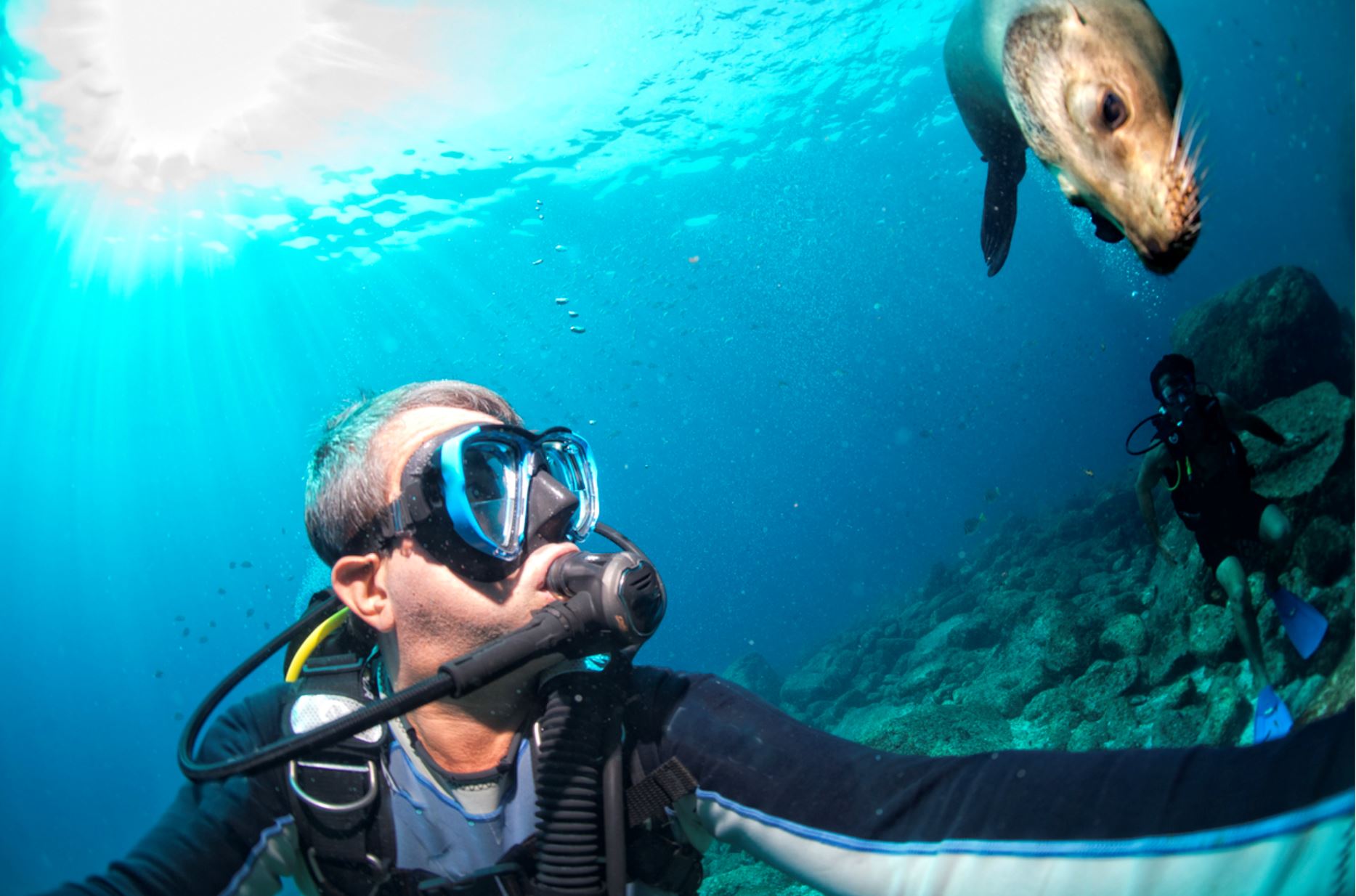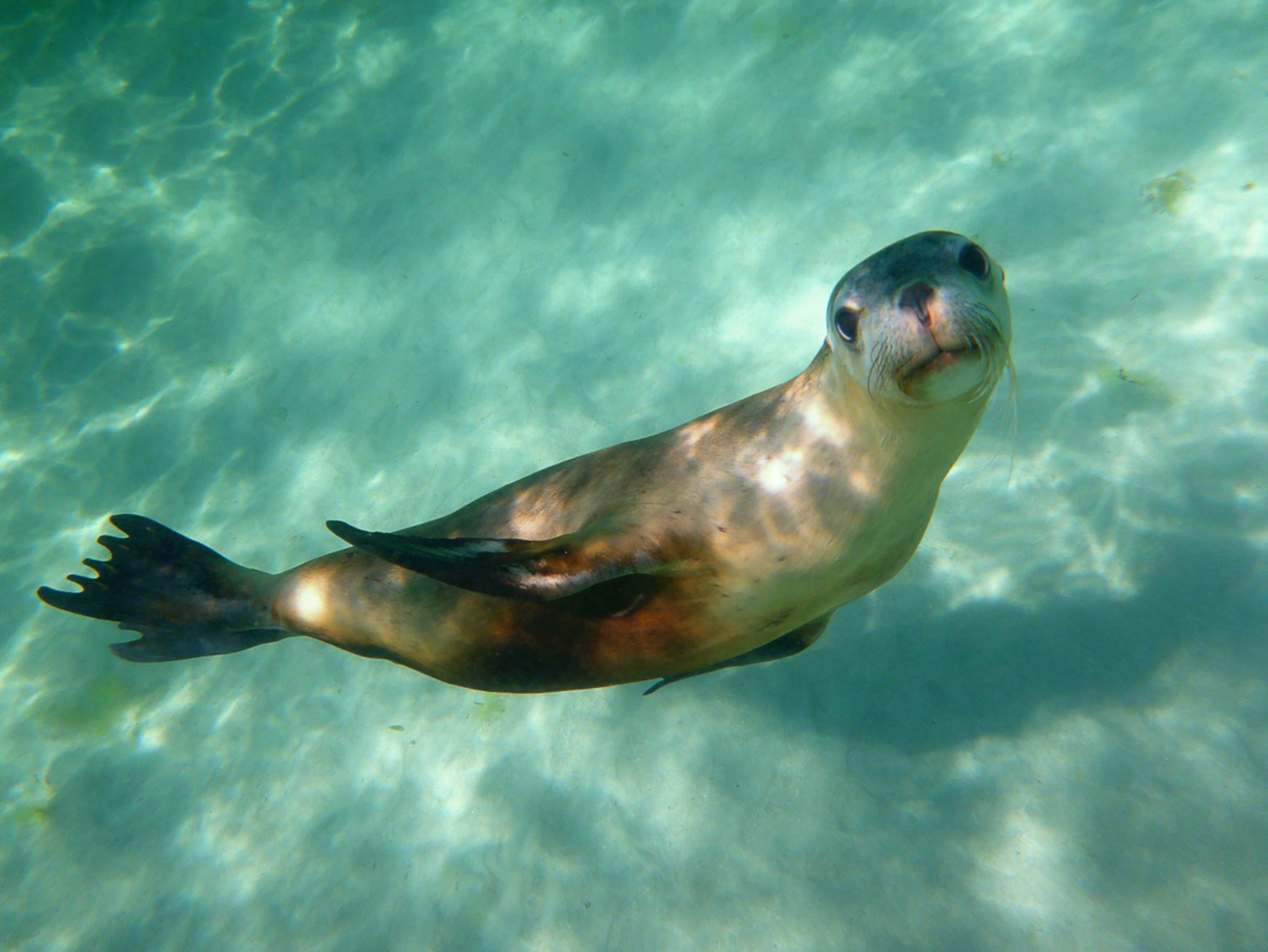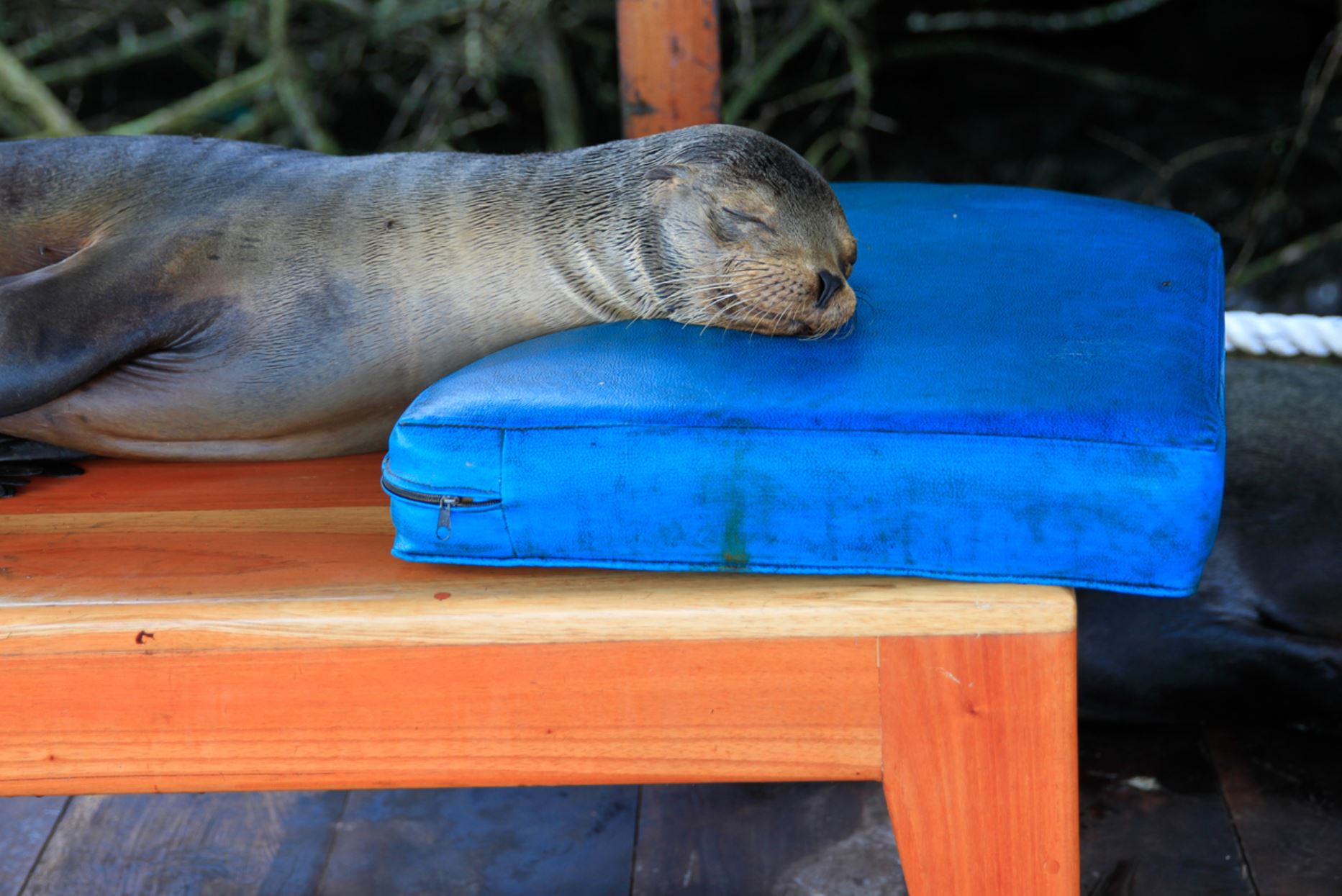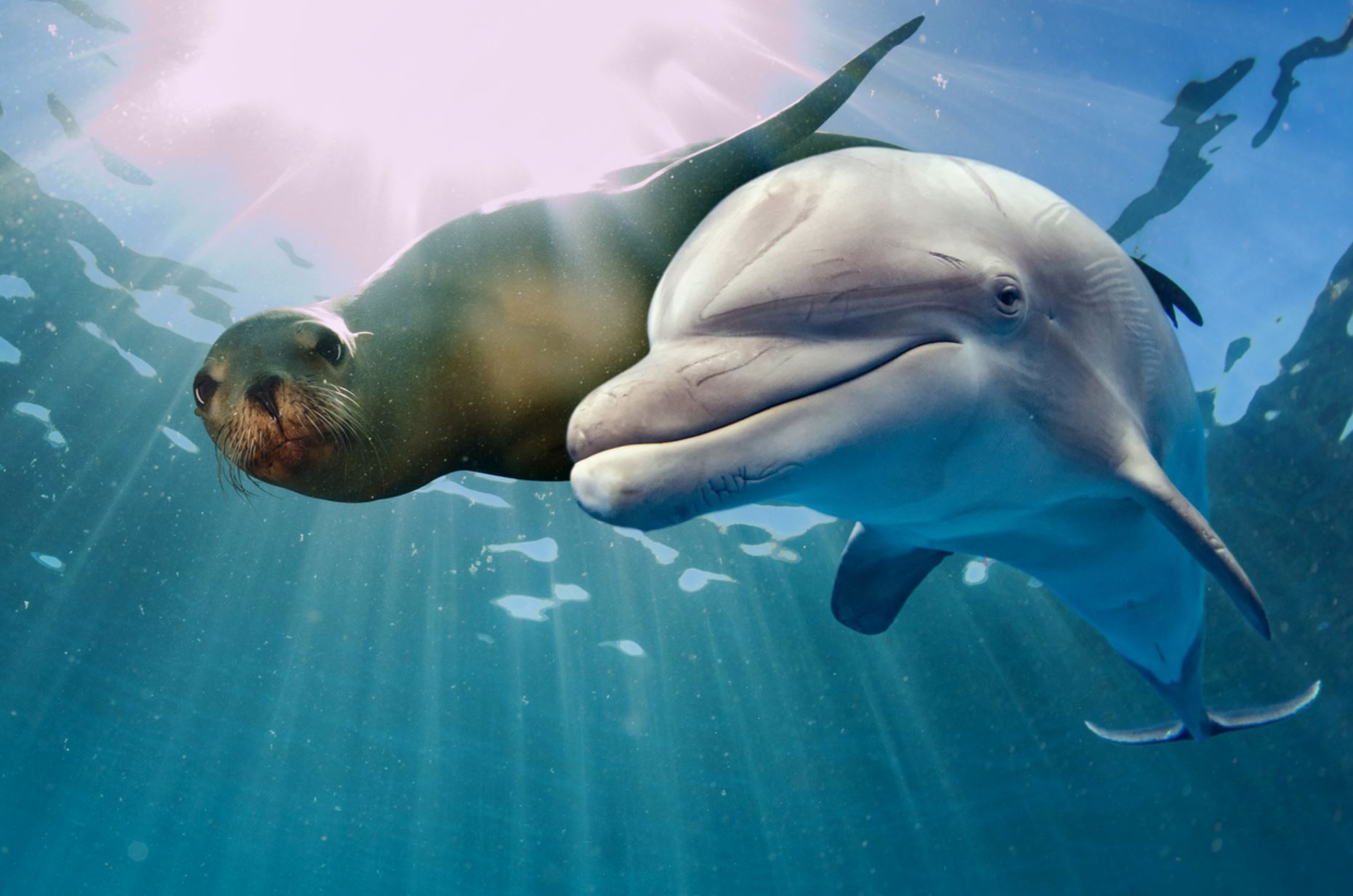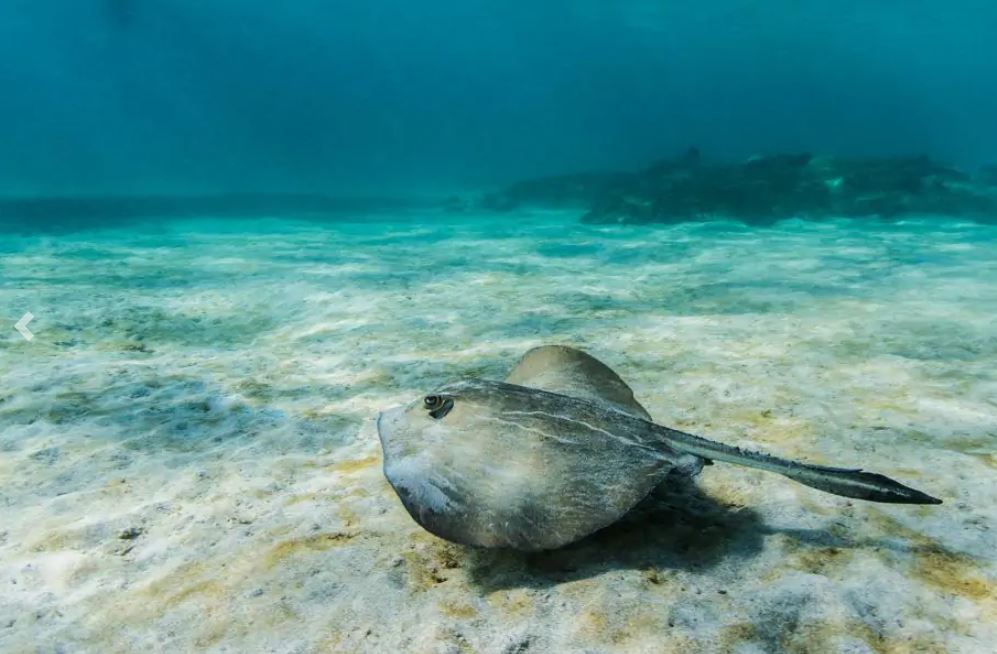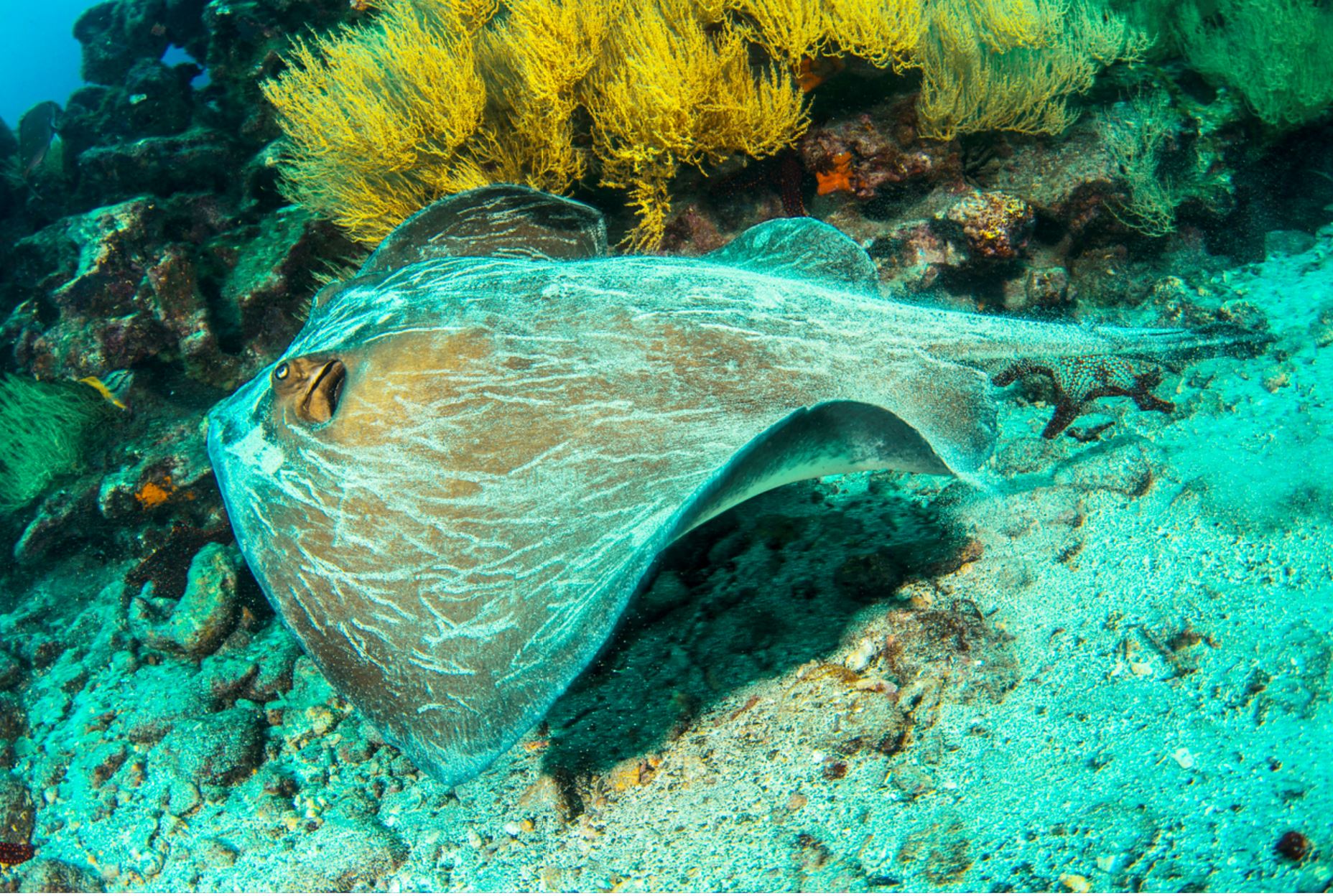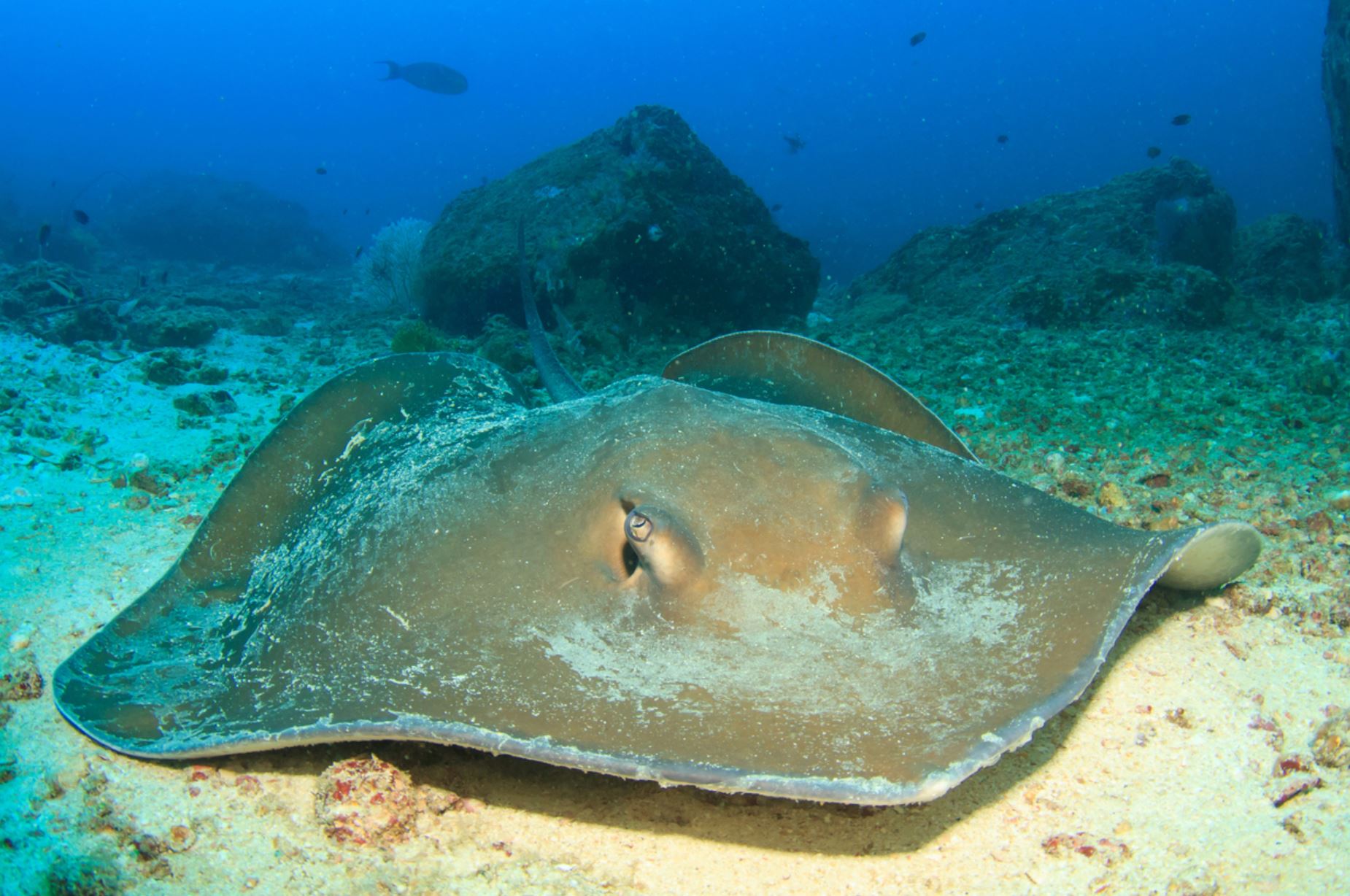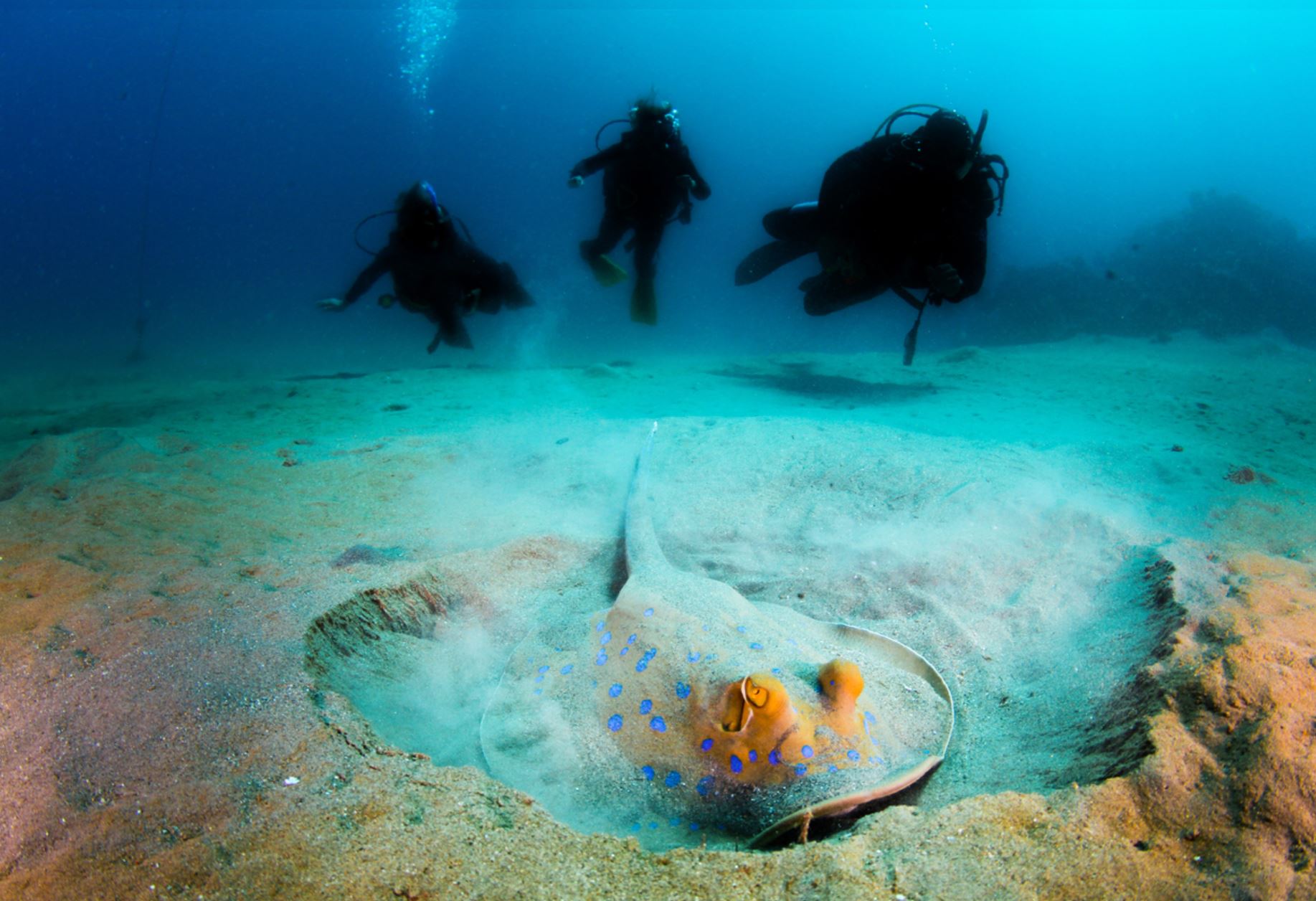North Seymour
Animals/Wildlife




Landscape/Views




Snorkeling




Beaches




This small island is one of the most important fishing sites for Marine Birds. This place is the reason for many travellers and ornithologists to observe the spectacular and diverse amount of birds of the Galapagos. The visit site is located next to the nesting area of Frigate Birds, both Magnificent and Common, that rest on the trees along the whole year. Witnessing the mating dance of the Blue Footed Boobies is also one of the highlights of the experience. There is additionally a Palo Santo forest that spreads on the south shore of Seymour where birds nest, and offer a spectacular view of the channel formed in between Bartolomé and Seymour. It is an unpopulated island.
Its formation is related to an uplifting of the underwater layer that resulted in a very eroded flat rock surrounded by risks. Here, the marine base is still evident, giant rocks and shells are found everywhere.
Hundreds of sharks such as the Tiger Shark, Galapagos Shark, Reef Shark and others, swim by the shore of this island. The Upwelling Phenomenon caused by the cold currents, enhance the marine diversity on this snorkelling and dive area.
Animals: frigate birds, blue footed boobies, sea lions, marine iguanas, swallow-tailed gulls, snakes, herons, hawks, sharks, rays
Plants: Palo Santo, Opuntia
Discover seabird colonies and witness up close and personal, the most intimate courtship, breeding and nesting behaviors.
Visitor sites:
A walk thru this wonderful small island North Seymour
Pictures
Highlights / Places to Visit
walking thru the island North Seymour
It is a fascinating place to see blue-footed boobies nesting and frigatebirds colonies.
The ground is at and strewn with Palo Santo or holy stick trees (a type of sandalwood noteworthy for its strong aroma) and gray saltbush, among white-splashed rocks. While walking, make sure you don’t step on any blue-footed booby nests. They won’t move, but you can. Respect their space and always follow the trail.
Activities: 25 min glass-bottom boat / 45 min deep snorkeling / 1 hour 45 min hike
Highlights: Blue-footed Boobies perform their courtship dance in the more open areas; Swallow- tailed Gulls perch on cliff edges; Great Blue Herons, Lava Herons, two species of frigate birds, and endemic snakes can also be spotted. You’ll find endemic land iguanas 3.9 ft (1.20 m) in length. Despite the tremendous surf pounding the outer shores, sea lions haul their slick bodies onto the beach and can be found together with marine iguanas. The vegetation is sparse and typical of arid zones
Animals that can be seen on the island
Blue-footed booby
The blue-footed booby is native to the tropical regions of the Pacific Ocean and is part of the six species of boobies. There are about six thousand blue-footed boobies in the Galapagos, typically nesting on the rocky shores and cliffs of the islands. Half of the world’s population live in the archipelago.
Their clumsiness on the ground, lead the bobby to be named by the Spanish “bobo,” which means silly or stupid. The blue-footed booby has an aerodynamic shape and the extraordinary binocular vision make it one of the best fishing birds. It breathes by the corners of its beak and their nostrils are permanently blocked as they dive to feed. They can reach the speed of 90kmh (60mph) diving in water, and they can go down to depths of 25m (82ft).
In males, the brighter the blue color of the feet, the more reproductive success they may have. Female boobies lay between two to three eggs a year, creating high competition between the offspring and resulting in one survivor that portrays natural selection in every generation. Both take care of the nest for about 45 days and feed the chicks together, by regurgitation for approximate two months.
The boobies are opportunistic breeders, preferring the cold season to mate (June-August). Overall, they tend to be monogamous and their courtship ritual is one of the most entertaining to witness. The male offers a present, usually a rock or a branch, and then dances in front of the female showing the feet and making noises while standing with the beak up high and the wings wide opened with tips to the sky.
Males and females are very similar, differences are that females are slightly bigger and have a larger eye pupil.
- Animal Group: Seabirds
- Scientific Name: Sula nebouxii
- Animal Average Size: 81 cm
- Animal Average Weight: 1.5 kg
Where can you find with a little bit luck the blue footed booby in Galapagos:
Rábida island
Isabela island
Santa Cruz
North Seymour
Floreana
Galapagos Dove
One of the more attractive and pleasant birds to encounter on the islands is the Galapagos Dove. The Galapagos Dove is a tame and well-mannered creature. It is reddish brown with black and white markings, touches of incandescent green, red feet and a bright blue eye ring. The Galapagos Dove grows to measure between 18 and 23 centimetres long. Its beak is curved downward, larger and more curved than most other doves.
The Galapagos Doves curved beak helps it feed mainly on seeds picked from the ground mainly from the Opuntia cactus. Cactus pulp forms part of their diet and is probably their main source of water.
The Galapagos Dove is endemic to the islands and is found in the more arid parts of the main islands. A process of evolution on Genovesa Island has softened the spines of cactus plants and thereby allowed the Galapagos dove access to pollinate the flowers. This has occurred due to the lack of bees that would normally perform this function.
The Galapagos Dove is most commonly seen on the ground where it forages for seeds and fruits. Even if disturbed it is reluctant to take to the air and if it does, it only flies for a short time.
- Animal Group: Landbirds
- Scientific Name: Zenaida galapagoensis
- Animal Average Size: 18 – 23 cm
- Animal Average Weight: 180 - 350 gr
Places where you may see this animal:
Isabela
Santiago
Rábida
Genovesa
Santa Cruz
North Seymour
Floreana
Española
San Cristobal
Galapagos Frigatebirds
The Great Frigate Bird resembles a huge blackbird that hovers lazily in the sky. Frigate birds belong to the family Fregatidae, which contains five species world-wide. In the Galapagos there are two species: the Great Frigate bird and the Magnificent Frigate bird. Of the two, the Great Frigate bird has the greater world-wide distribution, being found primarily throughout the tropical Pacific and Indian Oceans.
The Magnificent Frigate bird is found in the Caribbean and on the Pacific and Atlantic coasts of the Americas. The Galapagos population of Magnificent Frigate birds is considered to be an endemic subspecies.
In the Galapagos, the two species can be seen nesting side by side, but when Frigate birds are sighted in the air, they typically are Magnificent Frigate birds, as Great Frigate birds tend to forage much further out at sea. As with the three similar species of Booby birds, similar species of Frigate Birds avoid competition by feeding in different locations.
You can tell the two species of Frigate birds apart by their sounds – a Great Frigate bird makes a ‘gobbling’ noise like a turkey, while a Magnificent Frigate bird will make a rattling or drumming sound.
Great Frigate birds are large, with iridescent black feathers (the females have a white underbelly), with long wings (male wingspan can reach 2.3 metres) and deeply-forked tails. The males have inflatable red-coloured throat pouches, which they inflate to attract females during the mating season.
Both species of Frigate bird have extremely high wingspans to bodyweight ratios allowing them soar and to fly extremely well and with excellent control. Using this control, Frigate birds routinely steal food from other birds by grabbing them by their tail feathers and shaking them until they regurgitate their food.
However, Frigate birds are also capable of capturing their own prey. Since Frigate birds have only a small oil gland and very little waterproofing in their wings, Frigate birds cannot dive and must instead rely on their superb aerobatics to snatch flying fish out of the air.
- Animal Group: Seabirds
- Scientific Name: Fregata magnificens
- Animal Average Size: 215 cm
- Animal Average Weight: 1.1 kg
Places where you may see this animal:
Genovesa
North Seymour
San Cristobal
Floreana
Galapagos Land Iguana
The land iguana species has its origin in a common ancestor with the marine iguana, about 10.5 million years ago. The iguana grows up to a length of 1.5m (5 ft.) and can weight 13kg (25pounds). They are herbivores, feeding mainly on the prickly-pear cactus but eventually would feed on insects and other invertebrates. They reach sexual maturity at around 10 years old and can live up to 60 years.
They lay 2 to 25 eggs, which they burry in sandy areas. These eggs hatch after around 100 days. In some islands, they have interbred with marine iguanas creating a hybrid iguana species. Very little has been discovered from this species but they are known to be almost all infertile and have a very reduced population.
There are two other species of land iguana in the archipelago, the Conolophus pallidus, which is found only on the island of Santa Fe, and the one known as the pink iguana only found in Wolf volcano on Isabella Island.
Same as other reptiles, they need to thermo regulate so they bask in the sun to warm up making a beautiful picture, and usually burry themselves in the night to conserve the heat in the cold season. They are usually found in the trails and around the cactus growing sites. They have developed symbiotic relationship with birds so they can easily be seen with a finch standing on their heads. Since they are very territorial animals, some fights and social dynamics are part of their natural display. There are about 8 thousand land iguanas in the archipelago.
- Animal Group: Reptiles
- Scientific Name: Conolophus subcristatus
- Animal Average Size: 100 - 150 cm
- Animal Average Weight: 11.5 kg
Places where you may see this animal:
Fernandina
Isabela
Bartolomé
North Seymour
Santa Cruz
South Plaza
Galapagos Lava Lizard
Lava Lizards, scientifically known as Microlophus albemarlensis, are found on the Galapagos Islands. They are cold-blooded omnivores found in large groups moving around in the sun on top of the black lava that covers most of the islands. This movement in the sun keeps them warm, and gives them their name: Lava Lizards.
Galapagos Lava Lizards are small reptiles of 6-12 in (15-30 cm) long with tapering tails, slim bodies, pointed heads, long toes, and scaly skin. Their physical appearance, including their markings and color, varies based on where they live. Lava Lizards are of seven distinctive subspecies, out of which six species are found among six different islands with just one species inhabiting one island alone. They are commonly sighted all year-round and are usually active during the day. When mature, males have an intense coloring of a yellow, brown, grey-black speckling throat and a short crest of spiny scales along the back, whereas females have red or orange cheeks. Lava Lizards are unafraid of humans, so if you are ever lucky enough to see one in real life, you might be able to get your very own photo of these amazing reptiles!
- Animal Group: Reptilia
- Scientific Name: Microlophus albemarlensis
- Animal Average Size: 15 – 30 cm
- Animal Average Weight: 250 g
Isabela
Santiago
Santa Cruz
San Cristobal
North Seymour
Santa Fé
Floreana
Española
Galapagos Racer Snake
Racer snakes on Galapagos are constrictors and only mildly venomous. They are known to prey on lava lizards, geckos, insects, iguanas, mice, rats and hatchlings of several bird species. They are not at all aggressive towards humans and could not do much harm if they were to attack after being threatened. Racers tend to be dark brown with stripes or spots.
There is some confusion over the number of species of racer snake found in Galapagos due to poor research. The latest research suggests that there are: the Galapagos racer (Pseudalsophis biserialis) from San Cristobal and Floreana – though it is locally extinct on Floreana and now only found on nearby islets; the Espanola racer (Pseudalsophis hoodensis) from Espanola and adjacent islets; Santa Cruz racer (Pseudalsophis dorsalis) from Santa Cruz, Baltra, Santa Fe and adjacent islets; Fernandina racer (Pseudalsophis occidentalis) from Fernandina, Isabela, and Tortuga; banded racer (Pseudalsophis slevini) from Pinzon; and the striped racer (, ) from Baltra and Santa Cruz.
It is the Fernandina racer which has been observed hunting for marine fish from rock pools and the shallows around Fernandina. The British biologist Dr. Godfrey Merlen was the first scientist to ever see this behaviour happening as he noted up to 15 individual snakes slithering around the lava rock pools around Cape Douglas. This is a unique behaviour of terrestrial snake not observed anywhere else in the world. The racers on Fernandina were also the stars of BBC´s Planet Earth II where they were filmed hunting juvenile marine iguanas.
Racer snakes can be found in Galapagos on most of the major islands, though they are now locally extinct on Floreana. The snakes are found throughout the year, but unlike many other Galapagos animals they are shy of humans and will hide away making them reasonably tough to spot without looking for them specifically. They are diurnal, most active around dawn and dusk, and often rest around midday. The native snake population has been decimated by introduced species such as cats, pigs and feral goats which forage for their eggs.
- Animal Group: snakes
- Scientific Name (depending from the islands): Pseudalsophis biserialis, Pseudalsophis hoodensis, Pseudalsophis dorsalis, Pseudalsophis occidentalis, Pseudalsophis slevini, Pseudalsophis steindachneri
- Animal Average Size: 80 cm bis 1,20 m
- Animal Average Weight: 8 – 10 kg
Racer males can be found in Galapagos on most of the major islands!
Galapagos Sea Lion
There are two species of sea lions in the Galapagos: the most common one is the Galapagos sea lion (Zalopus wollebacki) and the other one is the fur seal (Arctocephalus galapagoensis). Both are endemic to the Galapagos and are believed to have traveled south from North America and northern locations.
The Galapagos sea lion is one of the most emblematic animals of the Galapagos, with a hight of 1.50m to 2.50m (60 to 100 inches) and can weigh up to 250k (550lb). These sea lions are different from their relatives in California, being smaller and more sociable. They have external ears and the capacity of using their strong frontal fins to gallop inland and climb the rocky shores of the islands. The Galapagos sea lion, prefers the beach to the rocks and form colonies on them.
This species presents sexual dimorphism, which means they have physiological differences between the genders. Males are usually three to four times bigger than females and are usually darker in fur tones, additionally, the adult males present a bump in the head known as sagittal crest. Sea lions are fully developed at the age of ten years old but are sexually active at six years old. Females live up to 24 years and males usually about 18 due to the extra energy expense during all the reproductive life.
When forming a colony, only one Alfa male will reproduce and take care of the whole group, in some areas like San Cristobal you can observe colonies of more than 300 in a single beach. During mating season (July to December) the males fight for territory and for reproduction. This can be an extreme show of strength and speed.
Females have one pup a year that takes 11 months to be born. The pup lactates from the female every day, after she returns from fishing, for as long as two years, sometimes competing with the previous year new born. Sea lions, do not synchronize their breeding, this results in one of the reasons for the decreasing numbers.
Sea lions feed mainly on small fish, sardines, squid and other mollusks. Data has revealed that they can dive down to 200 meters and hold their breath for more than 20 minutes.
Their natural predators are sharks and orcas, whales very rarely fish sea lions in the Galapagos. The biggest colony of sea lions of the archipelago is in Puerto Baquerizo Moreno and San Cristobal. Here these animals cohabit with humans, preferring the populated beach, to the isolated ones of the island.
The fur seal is smaller than the sea lion, about 1.5m (5ft). This subspecies is very shy and rare to see. They prefer the rocks, to the beach and they have nocturnal habits. Fur seals are less in numbers when compared to the sea lion, as they were heavily hunted back in the day by the first colonizers.
- Animal Group: Mammals
- Scientific Name: Zalophus wollebaeki
- Animal Average Size: 150 - 170 cm
- Animal Average Weight: 60 - 100 kg
Fernandina, Isabela, Genovesa, Santiago, Rábida, Santa Fé, Daphne Major, North Seymour, Mosquera, Floreana, Española, San Cristobal.
Galapagos Stingrays
Seen from the side, this animal is perfectly flat, with pectoral fins that extend to the head. The eyes are located at the sides of its head and with breathing cavities near. The diameter on average is from about 30 cm to less than 1 m. Stingrays are close relatives to sharks, with the common factor that both are cartilaginous fish that swim in warm waters of tropical oceans.
They will have one baby per year, and when the baby is born it will have to fend for itself. The females keep the egg and the juvenile in their uterus (ovoviviparous) from 2 to 4 months until the youngster is big enough to be born. No parental care is given to the newborn, it must be ready to feed and protect itself. Cartilaginous fish tend to mature at a slow rate, some studies say that they enter maturity when they are 20 to 30 years old.
Stingrays can spend most of their time buried on the seafloor and they have electrical receptors in their skin to help them read electrical charges in the ocean when looking for food and for orientation. Their favorite food is worms, fish, mollusks, crabs, and shrimp that they get by scooping through the ocean sand.
There are also other species in the ray family that can be spotted in the Galapagos: manta rays (the biggest of all, measuring about 4 m across its fins), golden rays, and spotted eagle rays.
- Animal Group: Marin Life
- Scientific Name: Dasyatidae
- Animal Average Size: 30 cm - 2 m
- Animal Average Weight: 7,6 kg
Places where you may see this animal in Galapagos:
Wolf, Darwin, Fernandina, Isabela, Genovesa, Santiago, Bartolomé, Rábida, Chinese Hat, Santa Fé, Santa Cruz, North Seymour Plaza Sur, Floreana, Española, San Cristobal
Location
Mr. Frobeen can give you precise information about the ships.
Mr. Frobeen will be happy to advise you by phone at +49 (0)7633 9399360 or via email info@frobeen.de
If you want to book, what are the payment methods?
The reservation is gratis as an option.
If you want to make an fixed booking, there is to pay a deposit of 20%.
The remaining payment is due 4 weeks before departure. In individual cases, such as diving cruises, other rules apply. Information on request.
- Your payments are insured against bankruptcy!

